BEGINNINGS OF OUR BUSINESS ACTIVITY
Shortly after we were married, my husband Josep went to work in my uncle's factory, Industrias Castelló, and it is there that he learned much of his mechanical knowledge from my uncle Francesc, who was a great specialist in tooling and mechanics. He has had Invention Patents since 1936. On January 2, 1949, together with my father-in-law, Santiago Escribano, they founded a Private Mercantile Company dedicated to metal stamping and the manufacture of closures for purses, under the registered name of Metamar and my husband Josep joins this company located at Calle Pujades, 20 in Poble Nou in Barcelona.


Patents of my uncle Francisco Castelló Carreras

My husband Josep Escribano at the beginning of the 50s
We also produced leather goods and jewelry under the name of Rosaga, my initials. In 1949, our company Metamar had assets of 400,000 pesetas, approximately 6 times the amount of a tower in Guinardo at the same time.
Awards of the Civil War of my husband Josep


My husband Josep in Valladolid on 12, 7, 1938

With my husband Josep and my sister Eulalia at the Art Street farm, 1940s

My uncle Pere Gallemí and Antonio, Francesc Castello's driver in his tower in Castelldefels, 1940s
My husband and I had 5 children, Françesc, Rosa Mª, Eulalia, Josep-lluis and Jordi, two of whom are deceased. For a mother, the loss of a child is the most unnatural and sad thing that can happen to her, and two even worse. Despite this, we fully enjoyed my children's childhood years together with my husband. On the occasion of the celebration of my 100 years, they asked me what had been the happiest moment of my life and without a second's hesitation I answered that the upbringing of my children, no material good or other circumstances could equal it and less surpass it. I also have to thank the unconditional help I always had from my mother Maria, by the way also a centenarian and she helped me a lot in raising my children. Thanks to this I was able to help my husband for many years in the activities of our factory, which at that time took place from Monday to Saturday included, since work in the post-war period was frenetic, given the scarcity of all kinds of products. In the 1950s and 1960s, customers paid in advance in order to have products as quickly as possible. Everything that was produced quickly sold.
The need for production personnel was very great, I remember that on the street door of our industrial warehouse at Calle Pujades, 20 in Barcelona, a sign was permanently hung that read: "Personnel needed". Entire villages arrived daily in Barcelona, mainly from Andalusia, where close 1 million people came from, most of them without any kind of training, who immediately alleviated with their desire to learn and work. I remember that, among others, we had the singer Manolo Escobar and people from Equatorial Guinea working for a while. In a few months the vast majority of them had fully integrated and in a short time they were buying their first apartment and their first motorcycle with bills of exchange, usually a Derbi or a Vespa, or their first car, a Biscuter, a Gogomovil or later everything a Seat 600. There was practically no labor conflict, people thought only of increasing their economic well-being and overtime and moonlighting were the most common, the youngest took time from where they did not have it to attend night classes of Vocational Training above all. In all this context, evidently the majority of the population did not think about politics, it is worth saying that they could not participate in it either, since there were no political parties and the main hobbies were soccer and bullfighting, depending on the area. They worked from Monday to Saturday and there were few holidays but the people were happy. During the 1940s and 1950s, the main hobby was listening to the radio, especially serials and programs like Elena Francis aimed at women. The most restless tried to tune in to Radio Pirenaica, which was broadcasting from Moscow at first and then from Romania, and which sounded terrible. Messages from the Communist Party arrived through it and speeches by La Pasionaria and Santiago Carrillo were common. In the 1960s, television arrived, which at first was in black and white and with a single channel, Television Española TVE. A little later a second channel arrived, the UHF and that was all in those years. The Franco regime immediately understood the strength of a single voice that it had in the single media and that almost all of people compulsorily followed, and Franco's government knew how to take full advantage of this exclusivity.
We began manufacturing in the 1940s, mainly metal fittings for purses, cases, compacts, travel items, toiletry bags, metal boxes to sterilize syringes, etc. Years later, already in the 1950s, we expanded our manufacturing to costume jewelery and we also began manufacturing lighters, being the pioneers of this type of product in the entire national market and before Flamagas S.A. (Flamasats S.A.) existed.
During all this time, the Puig family continued with its commercial representation activities in the Eau de Cologne sector and it was not until the 1960s that they began to slowly become involved with lighters, but only at the import level and thanks to the knowledge of my uncle Francesc Castelló, who on the other hand manufactured for them and for other clients, especially articles related to perfumery.

With my 5 children in Castelldefels, in one of the first Kodak color photos, late 50's

In the middle, my uncles Francesc and Elisa, behind me and my husband Josep, on the left my parents Joan and Maria, years 40

With my Falguera Balagué family in her house in Martorell and my parents, children and paternal uncle Pere, late 1950s

My uncle Francesc Castelló in Italy, 1950s

In Castelldefels

His first cousin Antonio Puig Castelló
In the mid-1950s, in our Industrias Metálicas Metamar factory, with 1,500 m2 and 140 permanent workers plus 70 external workers, we produced metallic articles for radios, television, pens, ballpoint pens, thermostats and for clients such as Lamps Z, Inter, Iberia Radio, Emerson, Hermetic Unit, Philips, Seat, Renault, Barreiros, etc. We had also started the production of metallic and liquid gasoline lighters, JUTSON brand, being the first and only ones in the market that manufactured this type of product and without any competition. My husband started a wide variety of types, shapes and finishes of lighters, gas fillers, spare parts and that later we would manufacture more and more models and quantities, as there was no competitor in the country, as he said. At the end of the 1950s, we also started exporting to the demanding Swiss market and later to other European countries such as Germany and also to American countries such as Chile, Argentina and Mexico, among others, which gives an idea of the quality with which we already produced in those years of so much lack.
From the very beginning, we had a fairly complete structure in our lighter factory, a mechanical workshop for our own production of the necessary dies, the metal drawing section with several presses, the electrolytic baths and painting section, the polishing section , the welding section, the faceting section, the butane gas section, the assembly section and also the verification or quality control section, the repair section and finally the dispatch and distribution section that I personally handled. On the other hand, we had the administrative and commercial part with 10 own vendors, all of them with company vehicles, not very common at that time. We also had our own Delegation in General Mola Street in Madrid. Already in the 60's we invoiced an important figure for the time, more than 100 Million Ptas.

Commercial card of my first company Rosaga years 40

Commercial card of our second company Metamar years 50
OUR LIGHTERS FACTORY METAMAR IN BARCELONA ON THE FIFTIES








Different aspects of the production of our lighters


METAMAR machining workshop at C/Pujadas, 20 in Barcelona, 1950s
Mounting section


Press Section
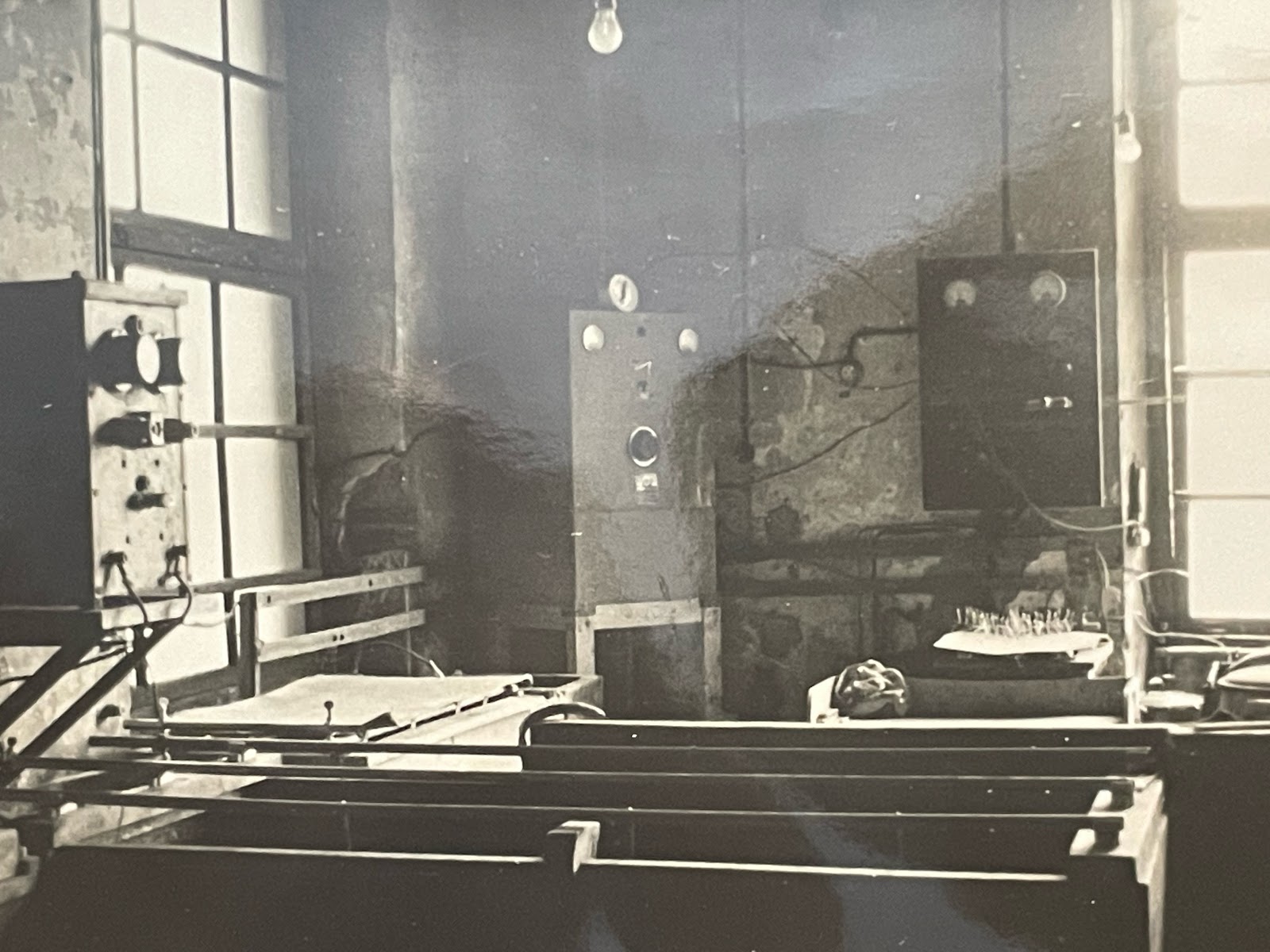
Electrolytic Baths Section
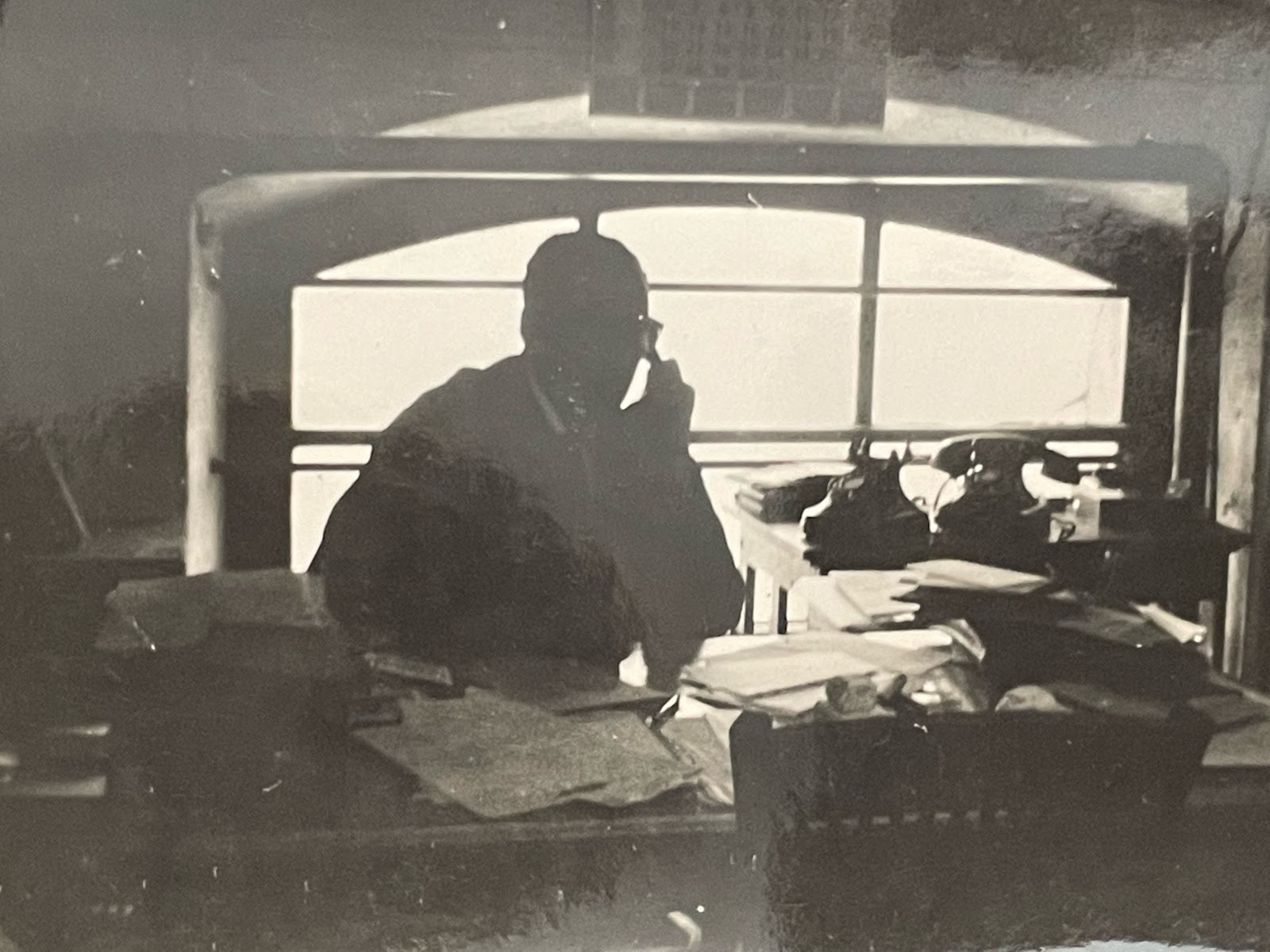
My husband Josep
These photos show part of the facilities of our Metamar factory, which were gradually renovated throughout the 1960s and early 1970s, adapting them to the needs of lighter production, which were becoming more and more sophisticated. all the way to the first refillable plastic lighters on the market, our Pronto-Lite and Roni models, before Clipper, Bic, Cricket and others saw the light. We were the pioneers of the market, as evidenced by our Invention Patents and our Catalogs, by the way, Pronto-Lite and Roni lighters later copied by these mentioned brands among others.

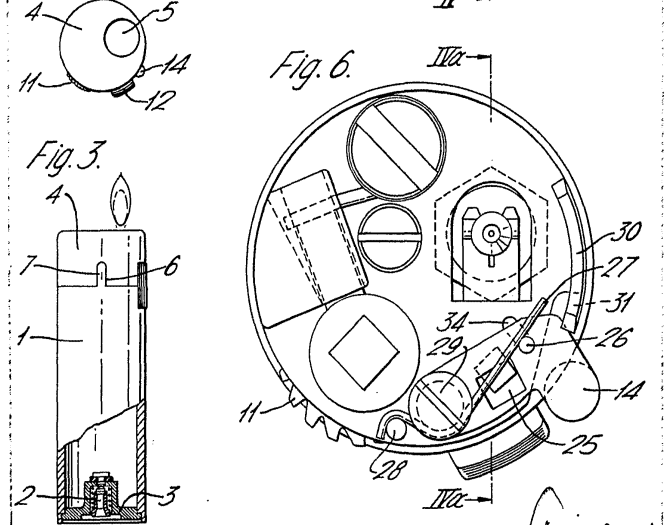
Jutson Pronto-Lite, photo and Patent of the first cilindric plástic rechargeable lighter in the market, produced by Metamar on 1966 and later on copied by Flamagas with his Clipper model
6 
Jutson Leaflet with the Pronto-Lite model
botton 
On the left our Jutson Pronto-Lite lighter, on the right the plagiarized Clipper lighter from Flamagas, the copy by the Puigs can be perfectly observed in the shape and other characteristics.


Roni, the first refillable plastic lighter with side button on the market
DEBT CONTRACTED BY PUIG AND NOT RETURNED UNTIL TODAY
A few years earlier, specifically in 1957, Antonio Puig Castelló asked us to hire his son Josep Mª Puig Planas, who was a young at the time and for whom his father was looking for an occupation to train him. My uncle Francesc Castelló, together with my father Joan Gallemí, Representative of Industrias Metálicas Castelló, did not hesitate to do him this favor and in this way he joined my uncle's company for a few years. I am attaching a letter dated 31, 10, 1957 in which my uncle informs the market that his company has since become an S.A. and where the name of Josep Mª Puig Planas appears as an employee.

Letter from my uncle Francesc Castelló where Josep Mº Puig Planas is mentioned as an employee and my father Joan Gallemí Claveria as Power Representative

Josep Maria Puig Planas

Marc Puig Guasch, ANTONIO PUIG S.A. Administrator

My father Joan Gallemi Claveria
On the same decade of the 1960s, Josep Mº Puig Planas asked me to sell him a farm that I owned on Maspons y Labros Street, in the Guinardo neighborhood of Barcelona, since the Puig family, in view of the such a rapid and positive evolution of our lighter company, he also wanted to enter this sector, thus establishing himself next to my uncle Francesc Castelló's factory on Art Street. Given the financial situation of the Puigs at that time, very different from now, I agreed to this by helping them with very advantageous conditions for Josep Mª, due to the friendship and family relationship that we had with the Puigs for many years before, a relationship that deteriorated later, as I will explain later. It is on this farm where they took their first steps in activities other than the Colonies and always hand in hand with my uncle Francesc Castelló.
A few years before my uncle's previous letter, Antonio Puig and his children bought a building in the Travesera de Gracia next to Calle Calvet in Barcelona to Dr. Gimenez Salinas, whose son José-Luis would precisely work with them for quite some time and they located there what would be his central office for many years. As I explain in my Notarial Act 1148 of 5, 8, 2014 of the Notary Bosch Carrera and that I can explain again before a Judge if necessary, not having the sufficient amount for said acquisition, the Puigs opted for a bank loan and the rest, taking advantage of the ties that united both families, asked me and my father to lend them an amount of 35,000 Ptas. in cash plus an additional 200,000 Ptas., a loan extended later as I will demonstrate in my next delivery. Some time went by and when the Puigs did not repay our loan, we repeatedly demanded said amount from their Agent Representative, Mr. Armando Soler Cayla, and the response at that time was that the Puigs' businesses were not doing well, which was possible and understandable. Talking to my children about this situation a few years ago, specifically in 2014, and making it necessary for me to collect this debt due to my already very advanced age, they explained to me that the situation of the Puigs had changed completely, being at this time the ninth declared fortune, only in Spain. Very deluded and innocently, I asked my son Josep-Lluis to go see Josep Mª Puig Planas or his nephew Marc Puig Guasch and ask them to repay my loan, since we understood that his financial situation had totally changed and for sure already they could return it without any effort or detriment on their part. He did so and specifically on July 2, 2014 he went to meet with Josep Mª Puig Planas at his central office in Exea on Av. Diagonal in Barcelona. After Josep Mª reminded him of several family aspects, my son demanded the repayment of my loan, which Josep Mª Puig logically did not deny and he specifically told him three times that it was difficult to calculate the amount of the loan in current money, he gave him many best regards to me and dismissed it as is. When my son explained to me what happened at his meeting, I told him to ask for another meeting with Josep Mª Puig Planas and that this time I would go personally to talk to him about my loan. He gave us the time for July 29 and what was our surprise that Josep Mª Puig did not show his face and did not appear, in his own office, at said meeting and instead he sent his two lawyers, Mr. Pedret and Mr. Blanco, who after extolling, precisely to me, the figure of the Puig family, asked us if we kept any receipt for my loan in question. My son and I looked at each other in astonishment at this situation. due to the ties that exist between us and we left the meeting totally surprised by the lack of gallantry and lack of honesty with which we found ourselves in those two meetings. We would never have imagined that after all the favors we had done to the Puig family in all these years, in addition to how they later enriched themselves at the expense of my family, as I will explain, the ninth fortune of Spain acted in this way, thanks in part precisely to my family and to help them when they needed it. But as they say, God squeezes but does not suffocate. Back home, we began to look for documentation of the debt, which we have continued to do to date, we have already found some document that I will show, and what was our surprise that numerous Invention Patents also began to appear in the name of my husband and my own that I did not remember and documentation of all kinds related to lighters manufactured by us. We immediately understood my husband's continued anger with the Puigs, since his Clipper lighter was a mere carbon copy of many of our Invention Patents.

Former head office of Antonio Puig S.A. Travessera de Gracia, Barcelona, sold recently by 15 Millions Euros
NEW DEBT OF THE PUIG PLANAS FAMILY
.jpg)
Receipt of a new loan to the Puig family and not repaid to date
As a continuation of my previous explanation of the loan that the Puig family has not returned to me and as I explained, on July 29, 2014, the date we agreed to meet with Josep Mª Puig Planas in order to claim his debt to me and at the time that he did not appear in his own office sending two lawyers, these two collaborators of him asked me if I had a Receipt for said loan, a question that I could not answer with certainty at that time, since in the years of my loan the word existed and honor among good people and much more with families and friends, circumstances that unfortunately have been lost in some cases. You will wonder that surely if they made this demand it would be to possibly repay my loan, which they have not done as I said. Well, looking for documentation to that effect and after the appearance of 35 Invention Patents and other records in the name of my husband and myself, which I will detail later, I did find this time, a Receipt where it is shown that at the time I made a new loan to the Puig family, as can be verified with my Income from the Banco de Vizcaya above and that I made on this occasion in the name of Maria Planas Cabot, aunt of Josep Mª Puig Planas. Again naively I contacted the past September 20th with Pablo Gonzalez, Financial Director of the Exea corporation of Josep Mª Puig Planas and family, in the confidence that this time, when presenting a Receipt of the new loan to the Puig family as they had requested me at the time, would they have the honesty to accept my new claim for the repayment of the debt. Once again, the Puig family has not even deigned to answer my claim for this new debt, demonstrating the arrogance and lack of gallantry that the 9th fortune of Spain has, financial situation in part thanks to me and my family, as I will explain further ahead. His request for a Receipt in my first frustrated meeting with Josep Mª Puig Planas, turned out to be a mere process of cheat and falsehood.
.jpg)

Receipts of the Plus-Valia of the sale of my land in Guinardo to Josep Mª Puig Planas
.jpg)
Ad of the time for which more than double is requested for a piece of land in Barcelona
As shown in the two previous documents, the conditions of the sale of my land in Guinardo to Josep Mª Puig Planas were extremely beneficial for him and his family, doing him a great favor by adjoining said land to his workshop, which would later become Flamagas. S.A., the latter land that was also sold by my uncle Francesc Castelló again to Josep Mª Puig Planas with very advantageous conditions.
START OF PRODUCTION OF OUR LIGHTERS

Plan of our J-7 wick lighter, one of the first we manufactured

Industrial Census of my company in Barcelona in the 50s
As this document from the Barcelona Industry Delegation from the 1950s shows, my husband and I were providing the data on our industry, indicating the figure of 50,000 lighters that we planned to produce annually.
Indeed, in the 1950s we were already producing Wick type lighters and Gasoline Flask lighters under our JUTSON brand. They were very cheap and quite simple products, but they always worked, without breakdowns. Flamagas did not yet exist and the Puigs did not know this technical sector, since they were focused on their Colonies. Several years would pass before they began their activities in this very different sector, copying our technique on many occasions.


J-7 wick lighter

Petaca J-1 lighter the 1st we produce

Photo and detail of a Jutson catalog from the 50s
We also patented and produced the windproof lighter whose flame never went out, the Armada, our Jutson 3 model and some more automatic models, such as the Jutson 6 model, all of them running on gasoline.


Jutson 3 model Armada windshield

Model Jutson 6
THE GROWTH DECADE
In the 1950s, all of society was trying to forget the war we had experienced and although we dedicated ourselves to working as many hours as possible, including Saturday and Sunday mornings, we also tried to find time to go out to dinner at restaurants in the Barceloneta and dance at places like El Cortijo on Avenida Diagonal. I fondly remember my dear friends Asunción Melé and Emilio Gardes, godparents of my youngest son, Joan and Angeleta Pinos, Drs. Russinyol and Hernandez, from Manresa, to Montserrat and Joaquim Borrás, with whom we celebrated the usual festivals and especially with the members of Mas Guinardo. I remember that the Borras, who lived next to my uncle's factory on Calle del Art, lent an office with a telephone in his house to Antonio Puig Castelló, since he did not have a telephone at that time.

With my remembered friend Asunció, years 50

Joan and Angeleta Pinos, my husband and I and Emili Gardés and Asunció Melé at El Cortijo

In Barceloneta with my husband, Asunció and Emili

My uncle Francesc Castelló Carreras and two of my children in Vic, the 1950s
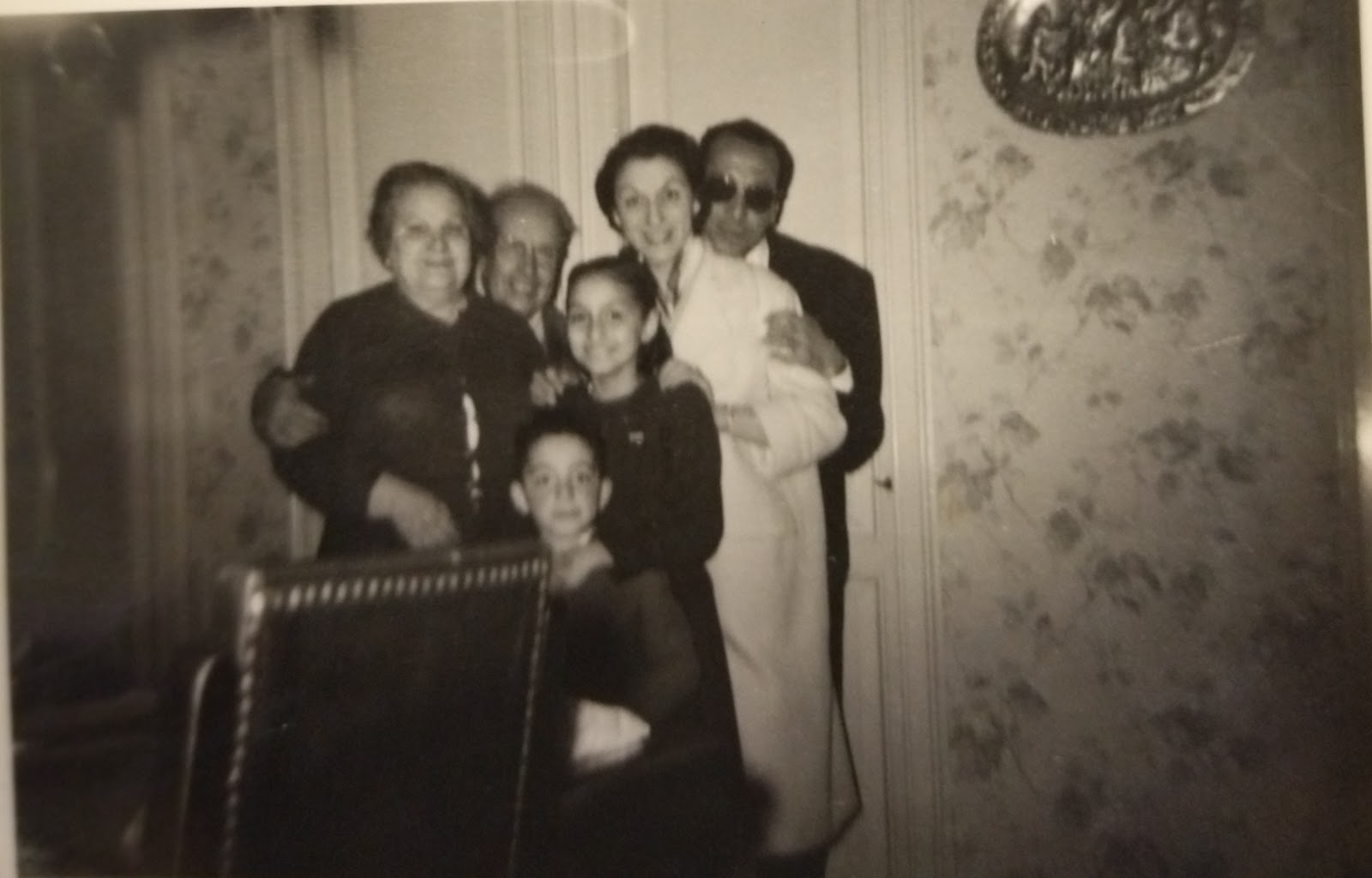
With my uncles Francesc Castelló Carreras, Elisa Balagué Sans, my husband and two of my children in his house on Calle Arts

Entrance to the celebration of the Golden Anniversary of the F.C. Barcelona, year 1949
One of our hobbies on Sunday afternoons was attending the various football matches at the Camp Nou of F.C. Barcelona. Along with my husband Josep and my friends Asunció and Emili, with whom we shared seats, we attended unforgettable matches, especially watching Kubala play and other players like Ramallets, Kocksis, Olivella, Villaverde, Foncho, Gensana, Villaverde, Segarra and many others, as well as when the eternal rival, Real Madrid, visited us, with their players like Di Stefano or the speedy Gento, even later I was able to enjoy Rivaldo, Ronaldo and Messi in their beginnings. I attended the inauguration of the Camp Nou in 1957 and years ago I received the Cub's Gold Medal for 50 years of seniority from a young President Joan Laporta.
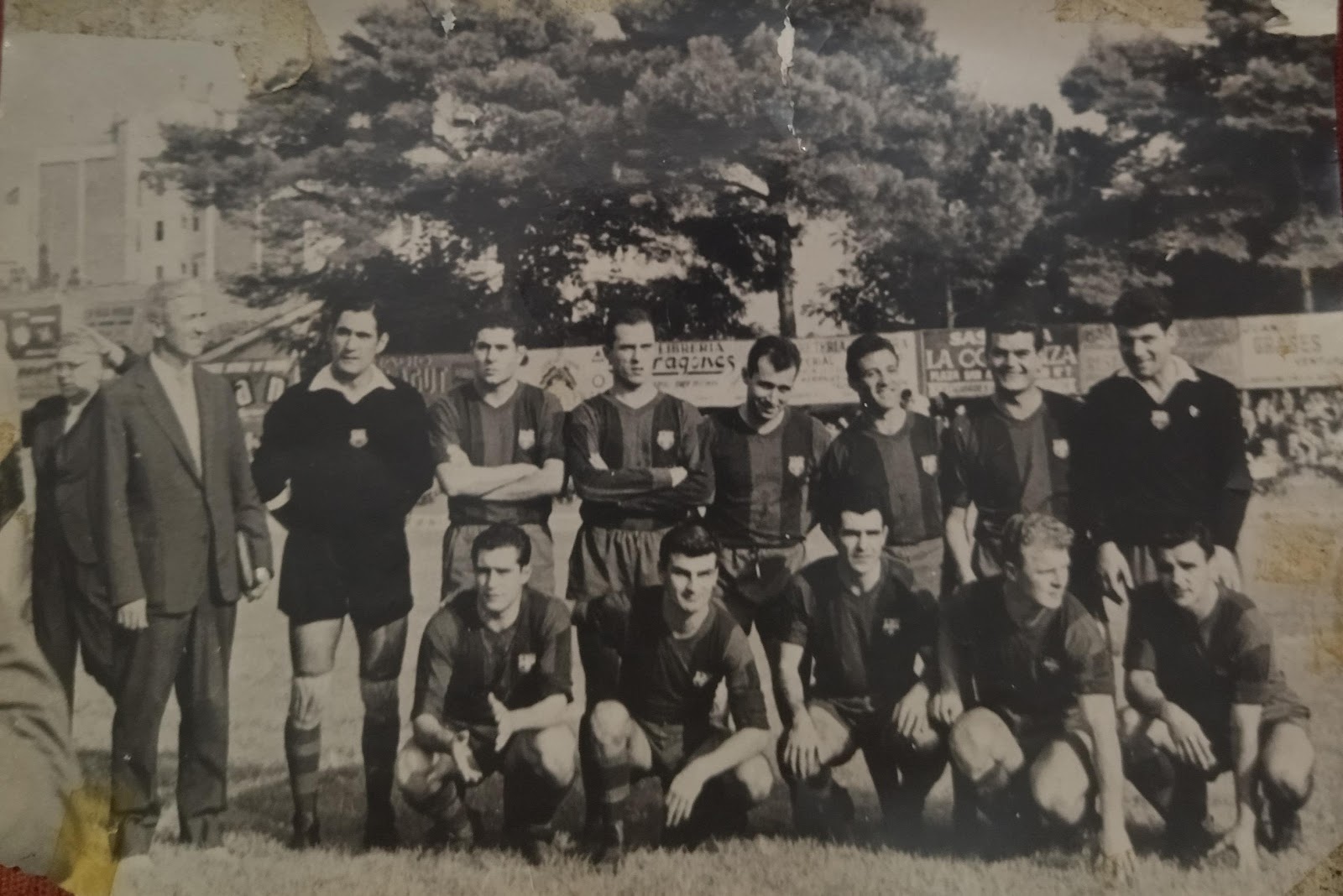
F.C Barcelona team on a visit to the Camp del Club Esportiu Europa in Gracia, close my home, 14, 8, 1960. CE Europa 2 + FC Barcelona 3, goals by Kocsis; Ramallets (Sadurní), Gensana, Rodri, Gracia, Olivella, Kocsis, Rivella, Evaristo, Coll, Villaverde and Kubala


My husband and two children in the field of Europe
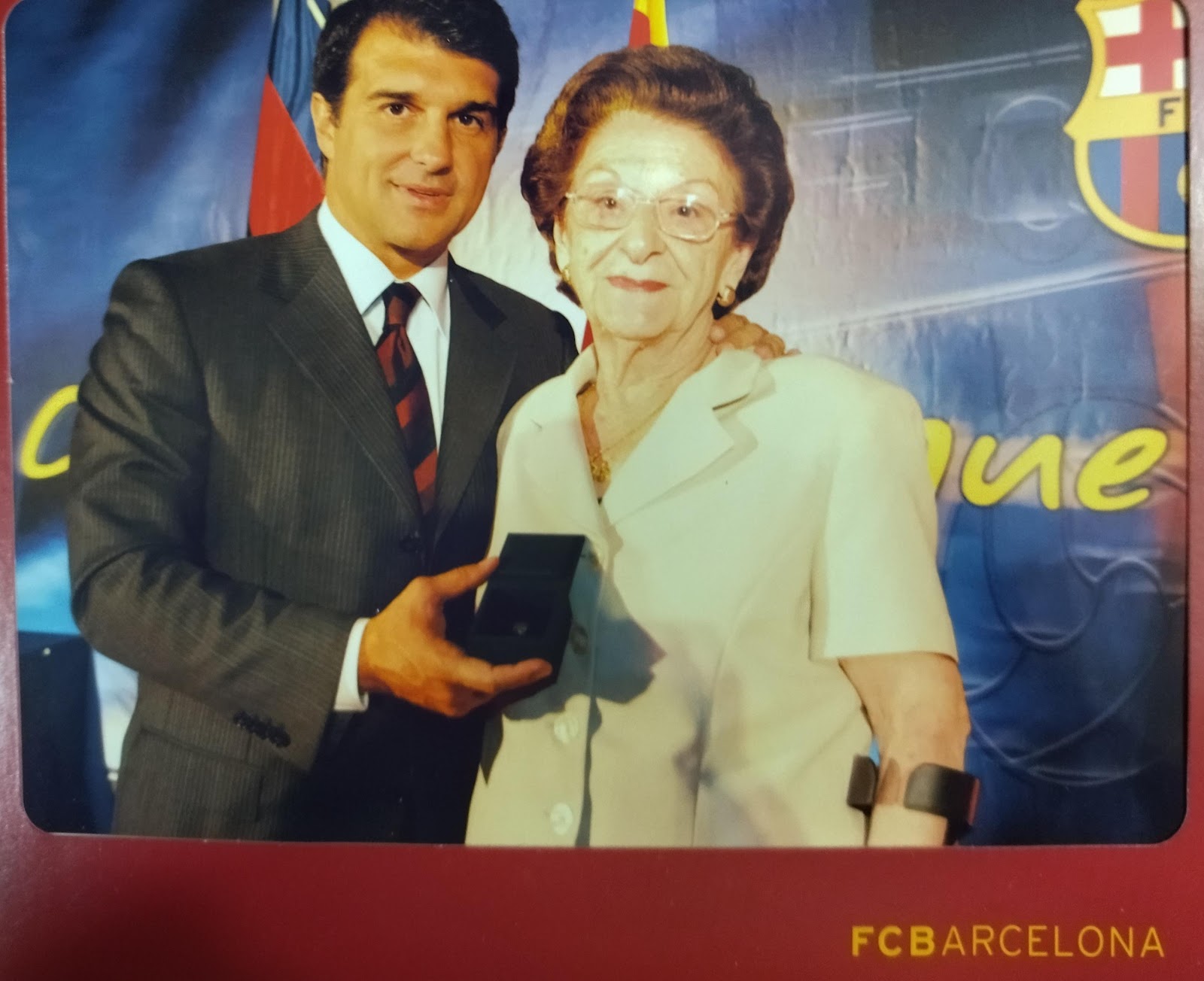
A young President Laporta at the award ceremony for the Gold Medal for my 50 years as a Member

On the left, Rosa Gallemí greeting the Countess of Barcelona exiled in Estoril, 1965
CONSOLIDATION OF OUR PRODUCTION - INDUSTRIAS METALICAS CASTELLO - MONTURAS Y FORNITURAS SA - START OF FLAMAGAS SA
Already during the early 1960s we began to experiment with the manufacture of gas lighters and parts of them made of plastic, not just metal. The first of them, the Jutson J-8 model, was a combination of metal on the outside and plastic on the inside, since the gas tank was made of this material. The plastic tank was replaceable with a new one as soon as the contents were exhausted. Another quality was its transparency, which made it possible to see the level of the gas inside and also the tube of the stone was accessible, so once it was worn out, a new one could be inserted. The client returned the empty gas tank and a new one filled with butane gas was provided. We were laying the foundations for what would be the future of the lighters that would arrive later, such as our own Pronto-Lite and Roni models and years later, the Clipper by Flamagas/Flamasats by the Puigs, which were not yet manufacturing in our sector and which, when they began later, would plagiarize numerous of our Invention Patents, as I will explain later.


Jutson J-8 lighter with internal gas tank, made of plastic material
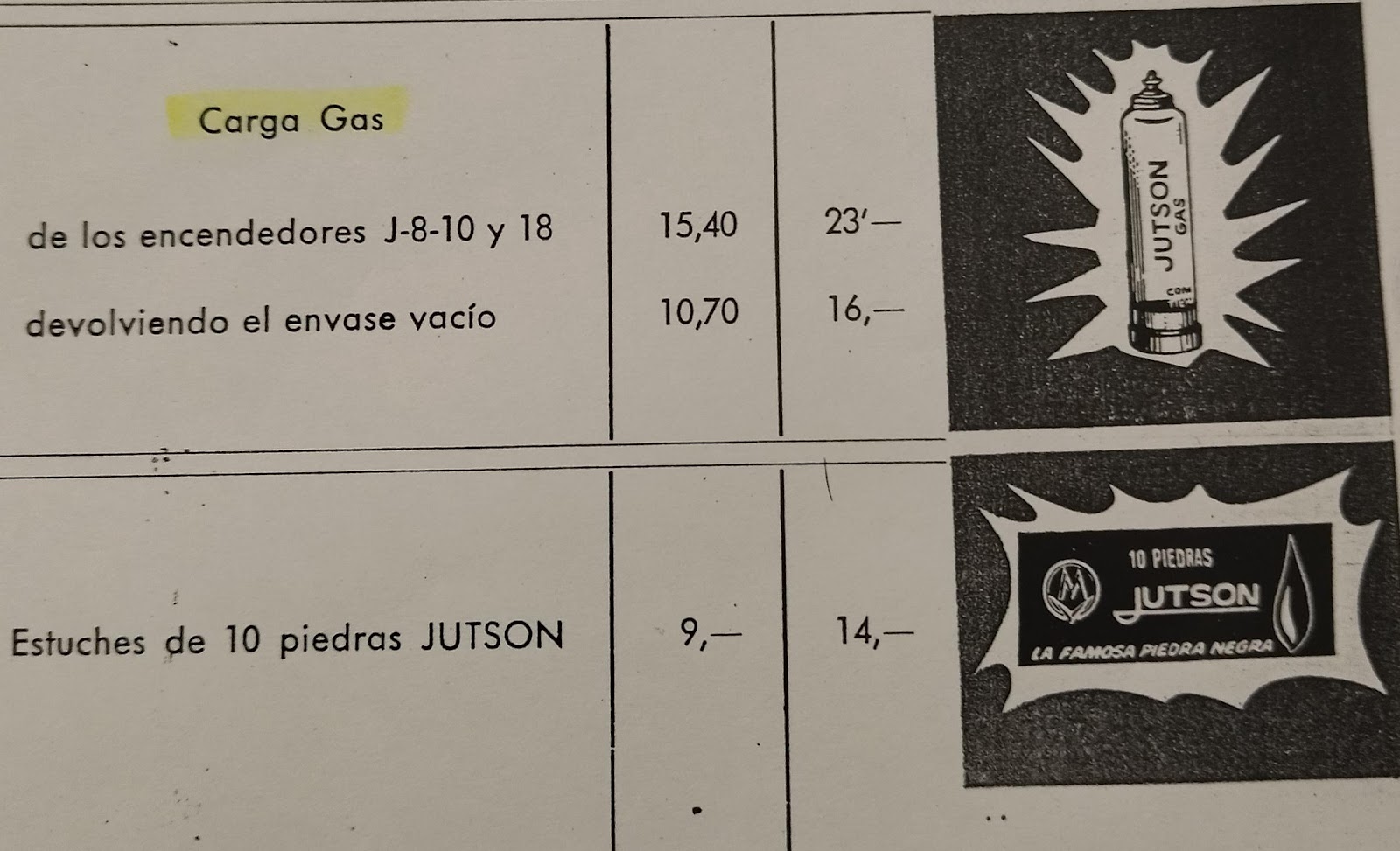
Gas Tank Refills for Jutson J-8 Lighter and Stone Refills
On the other hand, we also started the manufacture of table top lighters with our own metal and rechargeable gas machine and also renewable stone. Numerous different finishes and bases and shapes were created. They were the Jutson J-20 and Jutson J-37 models that were very successful at that time. Offices and living rooms used this type of practical and elegant lighter. This type of table top lighter was also copied by Flamagas/Flamasats.

Jutson J-37 desktop lighter

Jutson J-20 tabletop lighter

Detail view of the Jutson J-20 lighter


J-20 Tabletop Lighter Instruction Sheet

Utility Model 3753 of a Makeup Pencil by Francisco Castelló Carreras registered on 10, 5, 1935

Utility Model 121935 registered by my uncle Francesc Castelló Carreras on 2, 5, 1966 consisting of an Improved Ballpoint Pen dated 21, 5, 1966.

Utility Model 39307 of 1, 1, 1954 registered by my aunt Elisa Balagué Sans, consisting of a Cap for marking the numbers of the telephone dial.
Over the years, my uncles registered numerous Patents, specifically about 100 like these shown above, since 1935 there were numerous inventions that they applied in the production processes of their industries.
In the early 1960s, specifically on January 2, 1963, my aunt Elisa Balagué Sans and my uncle Francesc Castellas Carreras set up a new company called "Monturas y Fornituras S.A." and contributing the main capital, they accepted the minority entry of the Puig family in the shareholding, specifically Antonio Puig Castelló and his three sons Antonio Puig Planas, Mariano Puig Planas and Josep Mª Puig Planas as minority partners. My uncles registered with this company a total of 57 Patents and various Utility Models, most related to the aerosol and cosmetics industry, products that were manufactured over several decades in Barcelona. The company Monturas y Fornituras S.A. acted as a complement to the main company of my uncles, Industrias Metálicas Castelló S.A.
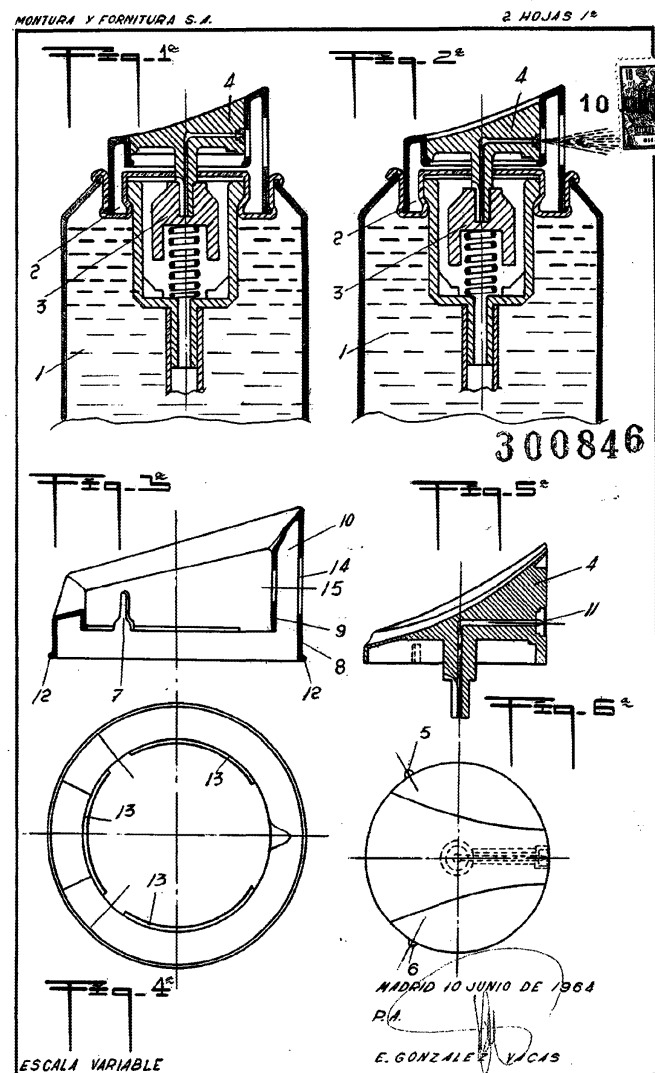
One of the first Patents for the Invention of Monturas y Fornituras SA applied for by my uncles on 10, 6, 1964, is about a Push Button-Diffuser for Aerosols.
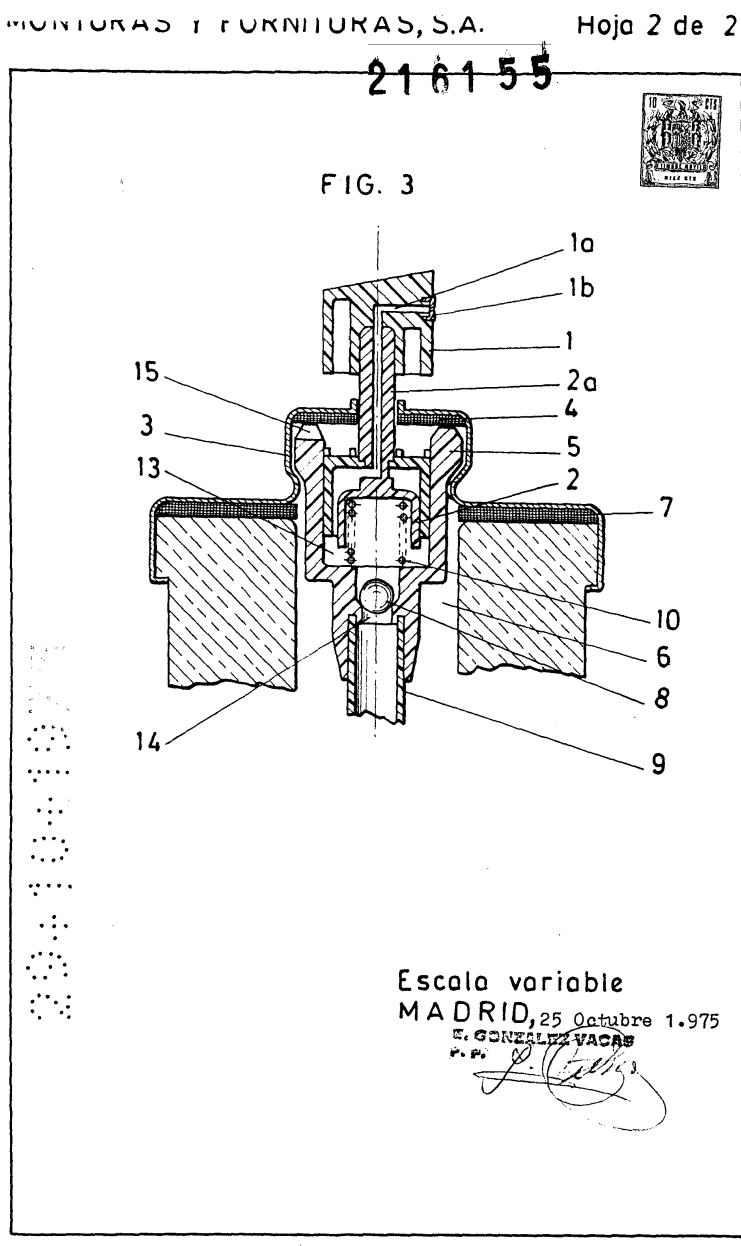
Manually operated distributor pump, Utility Model 216155 from 25, 10, 1975

Patent 290296 of a Lipstick Container from 24, 7, 1963 registered by my uncle Francisco Castelló

1958 advertisement for the Aerosols produced by my uncles
The company of my uncles, Industrias Metálicas Castelló, in addition to cosmetic products, produced Aerosols under license from the American firm Research Company of Illinois. It was one of the first Spanish companies to manufacture this type of product. In the world of cosmetics, it mainly produced lipstick containers for the firms L'Oreal, Margaret Astor, Christian Dior, Carolina Herrera, Yves Rocher, Lancome and also Aerosols for Cruz Verde, etc. The information from various sources and from the Puig family itself that Antonio Puig Castelló founded my uncle's company, Industrias Metálicas Castelló, is false, as evidenced by the document that previously included my entry No. 7 of this Blogg. In its final stage, the company passed through the hands of the Puigs and was a subsidiary of the multinational Alcan Riotinto, finally in 2009 it closed due to mismanagement after more than 80 years in the market.
At the beginning of the 1960s, specifically on January 22, 1960, the company Flamagas S.A. was registered. being my uncle Francesc Castelló its real promoter, from the very name of the company, to the start of the technical part. Once again, the Puig family does not tell the truth, since none of its members founded this company. Specifically, Messrs. Rio, Garcia and Reus accompanied my uncle in this new journey, as shown by the Mercantile Registry of Barcelona. The Puig family did not have sufficient technical knowledge coming from a totally different sector and thanks to my uncle's technical knowledge and experience, Flamagas was able to start its activities. In a first stage and for several years, Flamagas was limited to importing lighters from France and later in the hands of the Puigs, it was from this company that they began with his Clipper lighter and others to plagiarize many of my and my husband's Invention Patents as I will detail later.
ALLIANCE OF METAMAR AND THE GERMAN BRAND CONSUL
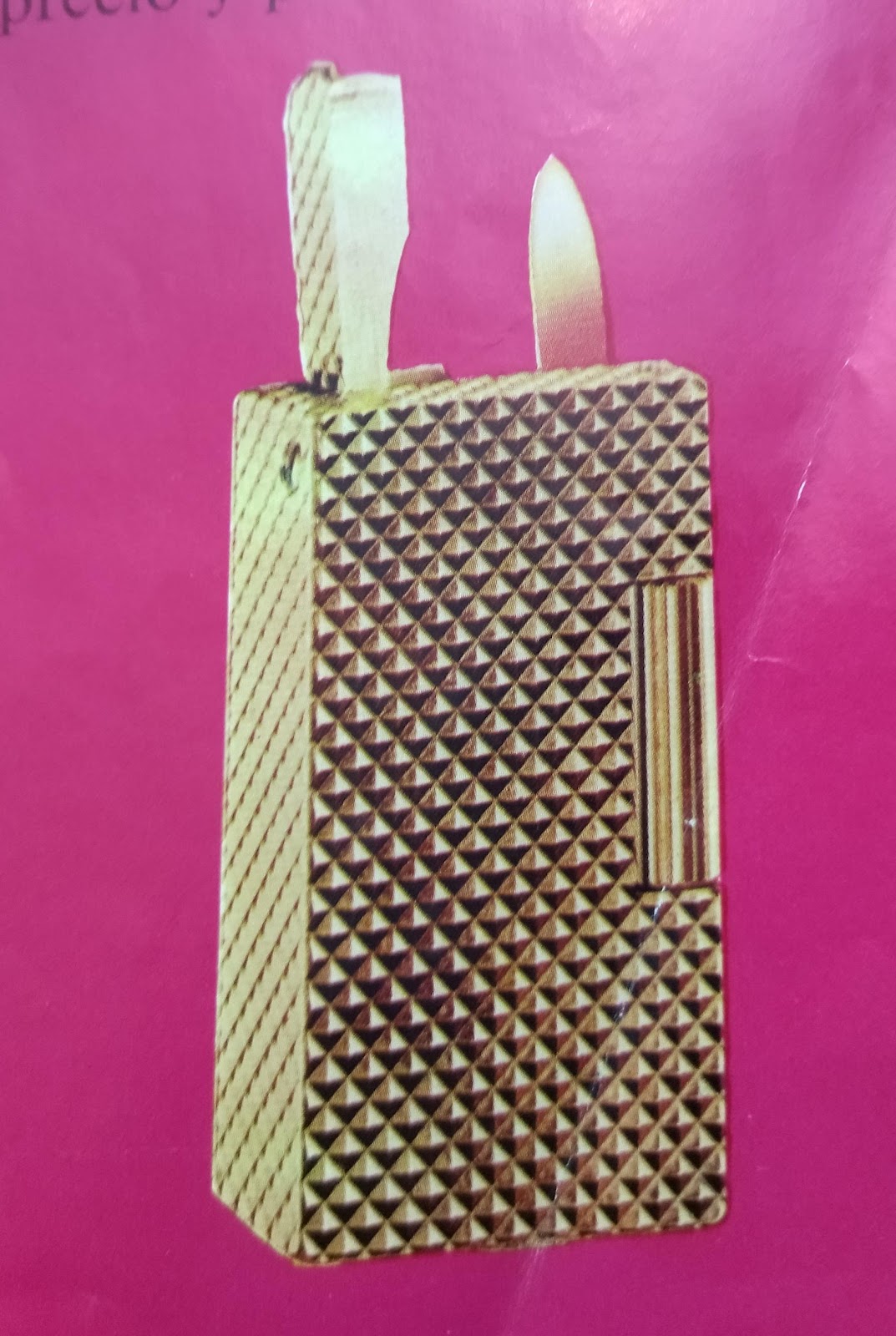
Jutson lighter Greco faceted gold plated model
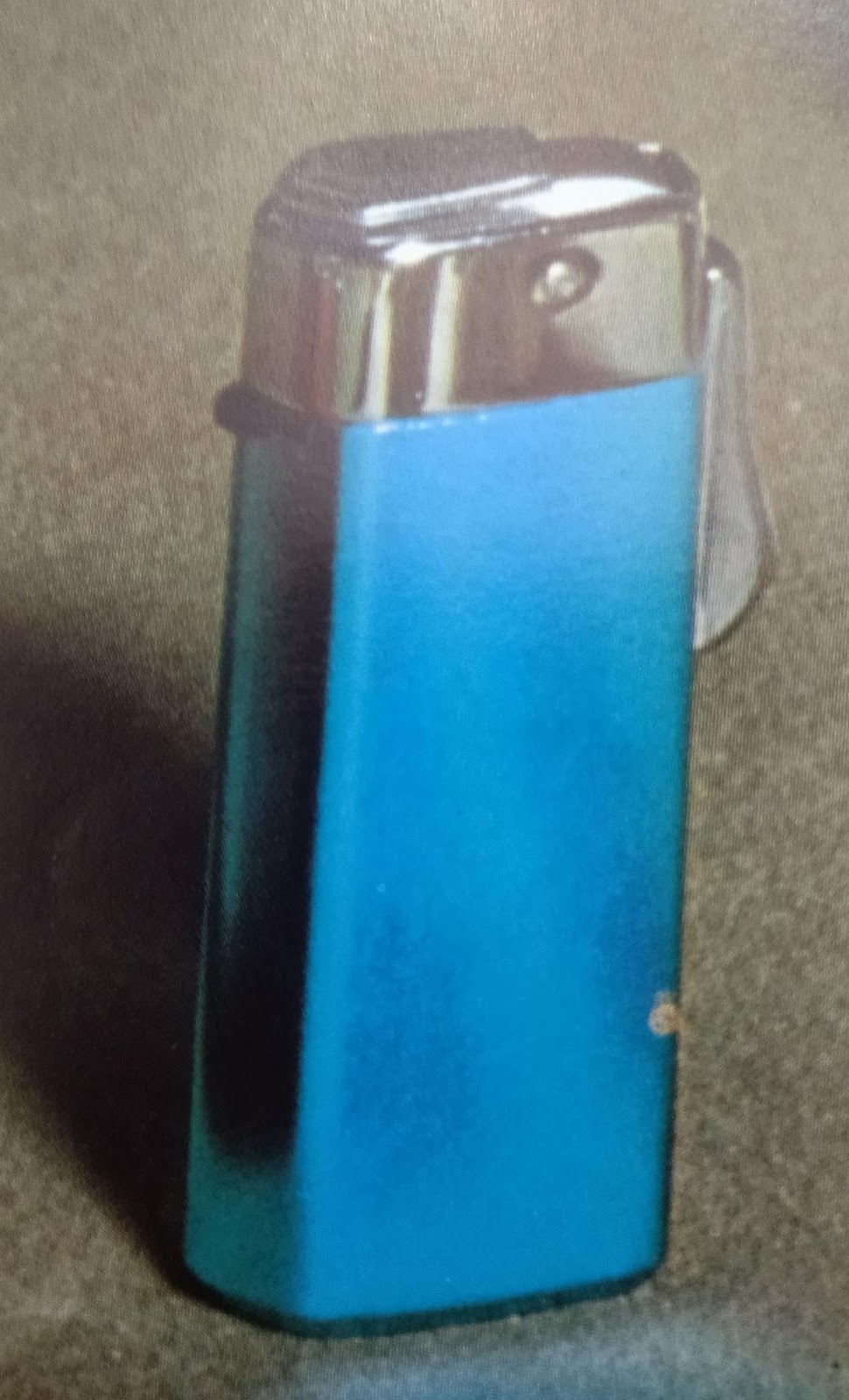

Jutson-10 automatic gas lighter and its breakdown
In the middle of the 1960s, our Jutson lighter factory continued to grow steadily, we produced 237 different models and they were increasingly more sophisticated and more automatic. In addition to being the leaders in the national market, we began to export to several countries as well as to markets as demanding as those of Switzerland and Germany. The machinery was already automatic in almost all models and gas was the predominant fuel, such as the Jutson-10 that just by pressing the side button, it turned on automatically. We also introduced the Jutson-Driver car cigarette lighter, very popular at the time, since the vehicles did not yet have an electric cigarette lighter and which was copied a little later by the competition. Likewise, we had a high-end lighter, the Greco model with a gold-plated finish and that, despite its high price, was very popular in those years. A family of products that was also very successful in the 1960s were our Universal or Multi-charge Gas Refills, since with them any brand of lighter on the market could be filled by adapting a specific nozzle for each type of lighter valve. This type of Multifill gas for lighters was plagiarized years later by the company Flamagas owned by the familly Puig.
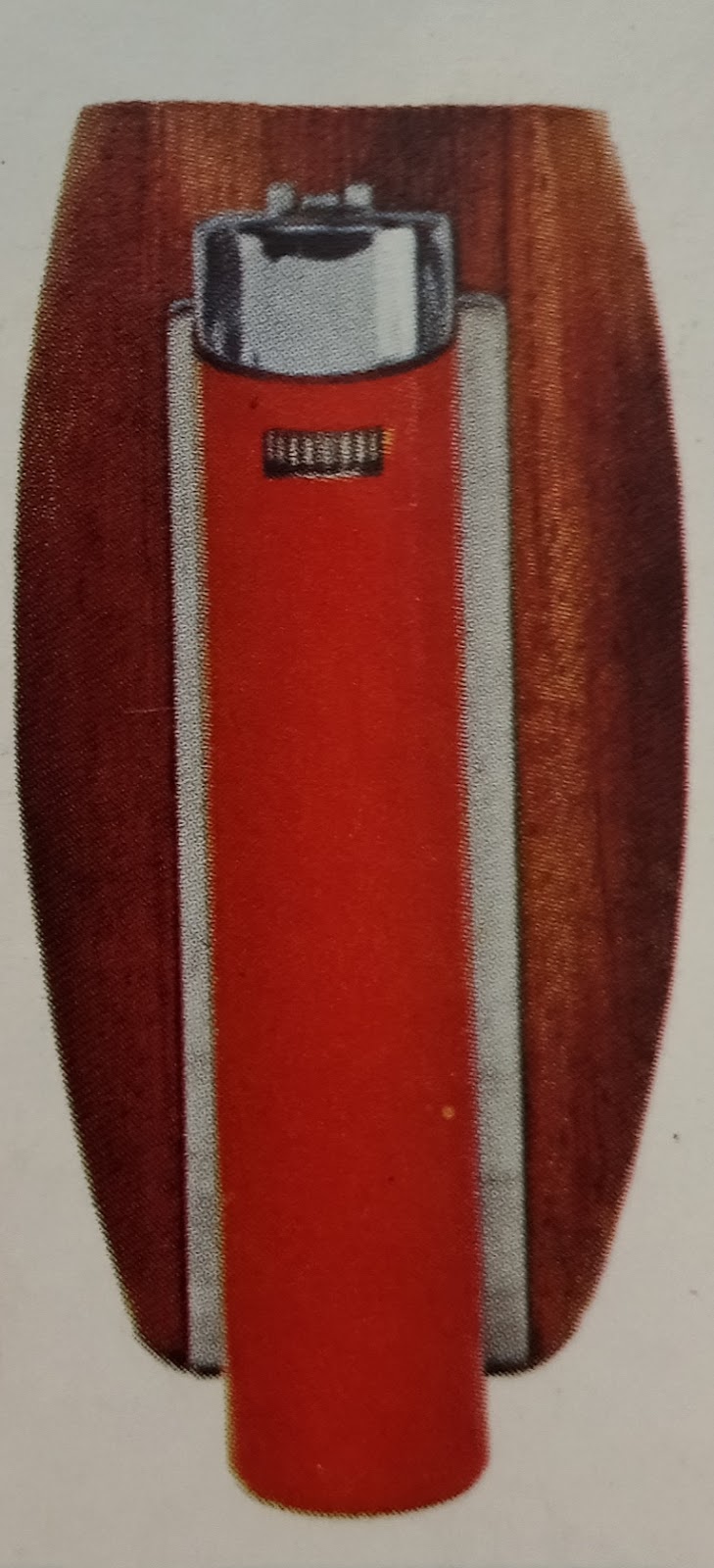

Jutson Driver car lighter and its exploded view

Our different Universal Gas lighter Charges or Multicharges

Our Universal Ibergas gas refill with the adapter nozzle

A few models of lighters from our catalogue from the late 60s


Two export invoices to Germany from the end of 1968 for 3,500 Sun-Gas model lighters and 2,000 Goya model lighters.
Thanks to our growth in the Spanish market and being the pioneers and market leaders, we had the opportunity for the most important European manufacturer of those years, the German brand from Nuremberg CONSUL, to trust our company and in 1967 we signed an agreement of representation for the launch of their lighters in the Spanish market through our company Metamar. Consul had nearly 1,000 employees and the most modern production technique. There were many models that we imported and many of them were designed by Count Sigvard Bernadotte, uncle of King Carl Gustaf of Sweden and who produced various designs of different types of products and the Royal, Facet and Crown lighter models.

La Vanguardia newspaper page of 30, 5, 1967 where are the news of the arrival in Barcelona of the president of the Consul, Dr. Bernard Köllisch and his interview with my husband Josep Escribano is published

Dr Ernest Bearl, Bernard Köllisch and my husband Josep Escribano

In 1967 we launched an advertising campaign in newspapers and on TV with the model Teresa Gimpera, which was very successful thanks to the fame of the Catalan model.
https://www.youtube.com/watch?v=ZOMijOevK58
TV ad for Consul and Teresa Gimpera lighters

Consul silver tabletop lighter

Table lighters Oldtimer Consul
 l
l
Sales meeting with the 14 Representatives of Metamar in 1969
LAST STAGE OF METAMAR
The new stage with the participation of the company Consul in our offer, meant a considerable increase in our penetration in the national market of lighters. At the end of the 1960s, the progress of our company was very positive and constantly growing. We were already sensing the possibilities and advantages of using plastic in lighters and we began to study the creation of a gas and stone refillable plastic lighter, which is why we created the first lighters of this type, the Pronto-Lite and Roni models that I spoke about earlier and I showed its photo and thanks to the immediate acceptance it had from customers who were looking for a cheaper type of product, we decided to create a fully automatic production line for the new J-38 lighter that would be aimed at being a revolution in the concept of cheap lighters, thanks to their rapid production in large quantities. A Swiss company from Geneva was in charge of designing and starting up the aforementioned automatic line. Notwithstanding this, little did we know that the Puigs were planning to copy many of our Patents to enter with great force into the production of plastic lighters similar to ours and as I will detail later.

Close-ups of the J-38 refillable plastic lighter

Not very clear picture of the first automatic production line of J-38 plastic refillable lighter
Likewise, we were the first in the national market to produce the electronic lighter that worked based on a Piezo-electric that facilitated the spark for the combustion of the gas inside. It was quite a novelty because for the first time the stone that produced the spark for the combustion of the gas could be dispensed with and instead said Piezoelectric was used, capable of producing a spark thousands of times without any failure. It was our J-47 electronic lighter that we sold thousands of quickly. Again this type of lighter was copied by the Puig and Flamagas/Flamasats very quickly as I will explain later.

Exploded view of the Jutson J-47 electronic lighter components

Jutson J-47 electronic lighter

Advertising of our Consul lighters in the Diario de Barcelona, 10, 6, 1967
DEATH OF MY AUNT ELISA BALAGUÉ IN STRANGE CIRCUMSTANCES-
START OF THE COPIES OF MY PATENTS BY THE PUIGS
On November 11, 1969, my aunt Elisa Balagué i Sans, who had been in the Alhama de Aragón Spa for a few days, died under strange circumstances at the age of 73. She had left Barcelona with her driver to spend a few days off with her husband Francesc Castelló and she died suddenly without suffering from any known serious illness that could have been the cause of said outcome. The whole family and I logically lived the loss of my aunt in a surprising and sad way, since nothing presaged a sudden end and also far from home. As a result of her death, all the properties of my grandmother and hers, Guinardo's real estate, her shares in her industries, etc. they passed to my uncle Francesc Castelló and later, as I will explain, to the Puigs.


Note of the death of my aunt Elisa Balagué where the companies Industrias Metálicas Castelló SA, Monturas y Fornituras SA and Flamagas SA from the Puig are mentioned
After a well-calculated follow-up of our industrial activities, already at the beginning of the 70's the Puig and Flamagas/Flamasats began to study the manufacture for the first time of their Clipper lighter produced in plastic, with a gas refill valve in its lower part, with the possibility of changing the ignition stone when it runs out, the flame regulation system, in addition to other features, etc. the vast majority copied from my husband's and my numerous Invention Patents and from our first Pronto-Lite and Roni refillable plastic lighters. They also began to plan the manufacture of the Universal Gas Multicharges for lighters, similarly copied from ours and later the electronic lighter with its mechanism exactly traced to ours. All of this was developing over a certain period of time, during part of which Flamagas bought our own Gas Multi-fillers and lighters from us, in order to be able to resell them in a first phase, since they still did not manufacture these products and make a detailed copy of them. And all of the above is not a possible invention of mine, but is corroborated before a Notary precisely by a former employee of Flamagas, Mr. Antoni Colell Gomá, who was the person who on numerous occasions came to our company to buy the Gas Lighters and Multicharges. that later Flamagas would use to make copies of them, despite all of them being previously patented by us and without ever requesting any authorization for said copies or ever compensating us for these continued plagiarisms and that still reach our days, having enriched the Puig in this way without any scruple. Mr. Antonio Colell Gomà confirms all of the above in a Notarial Act for having witnessed said copies. He personally lived in his company the copy by Flamagas of a large part of the components of my lighters and gas charges protected by my Patents. He personally, as he said, managed the purchases of our Gas Multicharges and Lighters, before his old Flamagas company was able to manufacture them by itself. He had visited our Metamar factory for it on numerous occasions and he was aware of the particular business policy that Flamagas followed with the competition and the habitual copying of registered Patents of other manufacturers.

Clipper lighter with stone ignition

Clipper Electronic Lighter

Universal Clipper gas multicharger
These three products, the Clipper stone ignition lighter, the Clipper electronic lighter and the Universal Gas Multicharger are the best-selling products and have been copied from my Patents for years by Puig and Flamagas/Flamasats and have been enriched them thanks to plagiarism commented. I will detail following the copies made by them of each mechanism.
.jpg)
Some of our gas refills for Jutson and Consul lighters
COPY OF MY PATENTS BY FLAMAGAS/FLAMASATS
As I explained earlier, at the beginning of the 70's the Puig-Flamagas began to manufacture the Clipper lighter, the electronic model and its Universal Gas Multicharge. As most of the mechanisms and techniques were already being used by our company Metamar based on our previous Invention Patents from several years before, they presented Utility Models of the same mechanisms most of the time, since the Utility Model it was the way to enter the market through the back door, that is, a kind of unapologetic filibustering. In this way they copied numerous of our Invention Patents to register Utility Models of a lower level and that collided and still do, with our claims of each Patent.
CLIPPER LIGHTER, UTILITY MODEL OF FLAMAGAS S.A. no. 175008
My Invention Patents nº 278004 and nº 285985 of 5, 6, 1962 and 12, 3, 1963 anticipate several years, specifically more than 9, to the Utility Model of Flamagas S.A. nº 175008 of 11, 12, 1971 referring to his Clipper lighter. I detail below the different copies

Invention Patent No. 278004 from 1962 in the name of Rosa Gallemí Balagué
PLASTIC TANK
Clipper's 1971 Utility Model 175008 drawings show the lighter itself, which can actually be referred to as a liquefied gas reservoir or container. In his Descriptive Memory page 1 point 5, he speaks of: “a tubular body of molded plastic material that simultaneously acts as a tank to contain the fuel in liquid state”. That is, it indicates that it registers a plastic tank to contain gas.
With my Invention Patent 278004, in 1962 and 9 years before, I was already patenting this type of tank for the first time and in plastic, as explained in the Descriptive Memory p. 3, point 5: "the main body of the tank (5) is obtained by giving a mass of moldable material, plastic or the like, a cylindrical configuration". This Patent opens the door for the first time in Spain in 1962, to the use of a tank to contain gas and plastic material.
Likewise, my husband Josep Escribano in his Patent of Invention 298348 of 6, 4, 1964 and 7 years before the Utility Model of Flamagas S.A. that concerns us, also records in section 10 page 3 the following: "especially if these (plastic gas tank) are made with moldable plastic materials".
GAS REFILL VALVE
In the description of Utility Model 175088 of 1971 of Flamagas S.A, they indicate that they have planned to incorporate a gas refill valve into their lighter, as stated in their description, page 6 point 5 "In the lighter that the invention proposes being of relatively cheap type, the possibility of being able to recharge it with fuel has been foreseen".
Quite a few years before the Utility Model 175088 of Flamagas, 6 specifically, my husband Josep Escribano registered on 4, 9, 1965 a new Invention Patent referring to a Gas Refilling Valve as stated in the description of said Patent nº 317129 in section 20 on page 3 when it explains: "it has a circular housing in which the corresponding fuel refilling valve will be incorporated".


In the image on the left we see my husband's Invention Patent No. 317129 from 1965 and on the right the Utility Model 175088 from Flamagas from 1971. In the lower part of each image, the two gas refill valves that use the same principle of the use of a rod or cylinder and a spring that allows its internal displacement at the moment in which the nozzle of a Gas Charge hits said cylinder, thus allowing the lighter to be recharged. Flamagas copied my husband's Patent 6 years later, as can be seen in these two graphs.

GAS OUTLET VALVE
Again Flamagas S.A. copy in your Utility Model no. 175088 of the Clipper Lighter another element patented by me, since in my Invention Patent 278004, I describe a gas outlet valve and as follows: "the upper one will be limited to the opening until it is reduced to a central passage in which a washer with an internal thread will be attached to the molded mass of the tank body to subsequently receive the outlet valve whose placement will be ensured by making it capture, when threaded, a sealing gasket interposed between said valve and the body of the tank "as seen in point 17 of fig.3 of the single sheet of drawings of said patent, while the Flamagas Utility Model 175088 on p. 36 section b) its 1st Claim can be read as follows: "A special simplified valve that controls the output of fuel", that is to say that it claims the same principle as the gas output valve.


In the image on the left you can see my Invention Patent No. 278004 with the Outlet Valve at the top of the drawing, which consists of a plunger that moves vertically through the action of a lever and thus allowing the contained gas to flow. in the lighter tank. In the drawing on the right we have the Flamagas Utility Model no. 175088, where we can also see in the upper part the same plunger that moves upwards when pushed by a lever, thus allowing the gas contained in the tank to circulate. of the lighter. Flamagas copies again with this Utility Model exactly the same system and parts as those of my invention Patent.
ADJUSTABLE GAS OUTLET VALVE
Likewise, I already registered a new Invention Patent No. 285985 on 3/12/1963, where with my Claims from 1 to 7 I report on an adjustable Gas Outlet Valve, as indicated in all the corresponding sections and as We can see in Fig. 1 and 4 attached. The Utility Model 175008 of Flamagas with its claim 1st section d) informs of "An improved lever for the activation of the special valve that controls the outlet of the gas necessary for combustion", that is, it is claiming an adjustable gas outlet valve . It also informs of its 11th claim, indicating in the 1st paragraph the following: "Gas lighter according to claim 1 that has a lever with which the valve that controls the gas outlet is moved to the open and closed positions...." , that is to say, it returns to claim an adjustable gas valve. already patented by me years before.


In these two drawings above you can see my Patent of Invention 285985 of 1963 where we can see in the image on the left the gas outlet valve and on the bottom right, a wheel with a series of teeth that allow the valve to rotate gas outlet, to allow the passage of the same in more or less quantity inside the plunger of said valve.
But on the other hand, my husband Josep Escribano, already patented an adjustable gas outlet valve and that Flamagas copied again 7 years later with his Utility Model 175088 that concerns us. Specifically, section 30 page 5 Claim 1 of the Invention Patent No. 301463 dated 6, 25, 1964 of my husband, reads the following: 1st Procedure in and related to the manufacture of valves with reduced and adjustable flow for fluids, characterized by obtaining a piece with a turned base". We can observe the drawing fig.2 of said valve on the single sheet of said patent and compare it with the drawing fig.7 sheet 2 of the drawings of the Flamagas Utility Model 175088 of 7 years later, seeing that it is a new copy of this company and that it registers with its aforementioned Claims, the 1st, section d) and the 11th 1st paragraph.


On the left Invention Patent No. 301463 dated 6/25/1964 of my husband Josep Escribano, on the right Utility Model No. 175008 of Flamagas where the same type of Gas Outlet Regulator that Flamagas copies can be seen.
Additionally, my husband Josep Escribano had registered a new previous Invention Patent, number 298408 dated 6, 4, 1964, where an adjustable Gas Outlet Valve is claimed, on which Flamagas based himself to copy it 7 years later in his Model of Subsequent utility 175008 for his Clipper lighter, as stated in section d) of point 20 of his Claim 1st page. 36: "An improved lever for the activation of the special valve that controls the output of the gas necessary for combustion", that is to say, it is claiming an adjustable gas output valve and as shown in fig.8 No. 45 of the 3rd sheet of his drawings. This Claim infringes that of my husband Jose Escribano with his patent from 7 years earlier, in his invention of the gas graduation of the outlet valves as described in Claim Note 1 on p. 6 where it is said verbatim: "Improvement in the manufacture of valve devices for gas burners, with adjustable pitch" and as can be seen in fig.2 and 4 of the single sheet drawing of his patent.


On the left Invention Patent No. 298408 dated 6, 4, 1964 of my husband Josep Escribano and on the right the Utility Model No. 175008 of Flamagas, where he copies my husband's Invention Patent 7 years later. The same type of regulator can be seen in both drawings.
In addition, my husband Josep Escribano, on 5/24/1965 registered a new Invention Patent with a new Gas Outlet Valve according to Patent No. 313322 and in which with his Claim 1, section 1 of point 25 page 4, he registers the "Improvements in the manufacture of valves with closing position and adjustable passage for fluids" as seen in fig.2 single sheet of said patent. Claim 1st page. 36 section d) of point 20 of the Utility Model 175088 of Flamagas, 6 years later, says: "An improved lever for the activation of the special valve that controls the output of the gas necessary for combustion", that is, it is claiming a adjustable gas outlet valve.


On the left, the Invention Patent No. 313322 dated 5/24/1965 of my husband with an Adjustable Gas Valve, on the right the Utility Model No. 175088 of Flamagas that again copies a new one of our Invention Patents, it can be Note that the Regulator on the right follows the same principle as ours on the left and contains the same parts and operation.
My husband Josep Escribano returns with Claim 1, section 20 of his Certificate of Addition 380991 attached and dated 6, 20, 1970, to register a gas flow regulator for the outlet valve as follows: "having said valve with a regulator operable from the outside of the apparatus in the form of a ring with a serrated inner edge”. We can see said regulator in point 8 of the single sheet drawing of said attached patent.


On the left we have the Certificate of Addition No. 380991 of 6, 20, 1970 of my husband and on the right the Utility Model No. 175088 of Flamagas where you can see the Gas Regulator copied again by the Puigs. Our lighter that can be seen on the left, the Roni model, was the first Gas Plastic and refillable lighter on our market together with the Pronto-Lite model, prior to the Clipper by Flamagas.
In Clipper Utility Model 175,088, section 25 of the report, p. 9 talks about his alleged invention consisting of an arm that regulates the length of the flame of the gas outlet valve and says exactly the following: “The upper edge has a flange directed inwards; the interior is smooth and at the front it has a slot through which the arm with which the length of the flame is regulated appears.” and he registers it with his Claim 11th section 10 page 42 as follows: "Gas lighter according to claim 1 that has a lever with which the valve that controls the gas outlet is moved to the open and closed positions" . That is to say, it is registering the same gas flame regulator concept that my husband Josep Escribano registered 1.5 years before with his Certificate of Addition 380991 and my Patent 285985 8.5 years before both previous ones.
It is clearly demonstrated with my 6 Patents described above the copy of Flamagás in the design of the Gas Outlet Valve of his Clipper lighter years later, as described by his only Utility Model commented on him.


Image on the left, drawing of my Invention Patent No. 278004, image on the right, Utility Model no. 175088 later by Flamagas.
TANK TRANSPARENCY
The later Flamagas Utility Model 175088 indicates that its lighter is made of a transparent material that allows the fuel content to be observed. Section 25 page 4 of his report says: "Due to the transparency of the material that makes up the aforementioned tank, it is possible to observe its fuel content at all times, which can be replenished, when it runs out, through the fuel valve. load incorporated in the lower base of the tank”.
This quality and advantage of the transparency of the gas tank was already invented and registered by me 9 years before in my Invention Patent No. 278004. Indeed, in section 25 page. 4 of the specification of said patent, the following can be read: "As for the manufacturing system described, moldable materials or plastic in general will be used to obtain the body of the tank, it will suffice to use one of said materials with a certain condition of transparency so that at all times, through the walls of the tank, the amount of cargo contained can be directly appreciated”.
The later Utility Model 175088 of Flamagas copies the quality of transparency of the gas tank that I had invented and registered 9 years earlier with my Invention Patent 278004.
REPLACEMENT OF THE PYROPHORIC STONE OF THE LIGHTER
Utility Model 175088 of the Flamagas Clipper lighter describes a system that allows the possibility of replacing the flint of the lighter once it has been consumed and as it says in its following description in section 5 on page. 6: "the possibility of being able to recharge it with fuel has been provided, as well as to replace the pyrophoric stone when it has run out" by extracting the mechanism that houses said stone. Likewise, it explains it in its Claim 14, point 10 and 15, page 44, indicating: "this device is also characterized by consisting of a cane or tubular sector with a lateral opening through which the pyrophoric stone is introduced."
Well, this mechanism had already been invented and registered by my husband Josep Escribano previously and more than 1 year before, specifically in the Certificate of Addition no. 380991 dated 6, 20, 1970 (referring to his Invention Patent 297475 attached dated 10, 3, 1964) and that it says in section 15 p. 3 of the memory, the following: "outflow, operable from the outside, in the form of a ring clamp with a serrated inner edge. The rocking lever is perforated in its middle area to allow the tube to carry the ignition stone through this perforation, and it registers this in its 3rd Claim in section 5 on page 5. 5 of his patent explaining: "which acts by compression on the tube carrying the ignition stone". Indeed we can see at point 9 of fig. of the single blade, the tube carrying the ignition stone with a spring-loaded screw that allows the replacement of said stone once it has been exhausted. Therefore, it can be confirmed that the later Utility Model 175088 of Flamagas infringes again with its 14th Claim, point 10 and 15 on page. 44, Claim 3, section 5 on p. 5 of the previous Certificate of Addition No. 380991 of my husband Josep Escribano.


Image on the left of my husband's Certificate of Addition No. ES380991 where we can see on the right the Stone Holder Tube with a spring and closure that allows the change of the stone when it runs out. Image on the right of the later Flamagas Utility Model 175088 where we can see the same system of Stone-Carrying Tube with spring from the Clipper that once again plagiarizes one of my Records.
OPENING LEVER FOR THE GAS OUTLET VALVE
My husband Josep Escribano in his Attached Certificate of Addition 380991 commented on 6, 20, 1970 perfects his previous Invention Patent 297475 by registering an Opening Lever for the gas outlet valve of a lighter and as stated in his 1st Claim section 15 sheet 4 as follows: "Improvements introduced in the object of invention patent number 297475 on improvements introduced in spark-producing devices for gas ignition with the container for said fluid incorporated, characterized by the fact that the incorporation of this container is It is completely carried out, being constituted by a cylindrical cavity integrated by the walls of the body of the apparatus itself, closed at its lower end with the base carrying the loading valve and at its upper end by incorporating the outlet valve from which the plunger protrudes which is actuated by the rocking lever, having said valve an actuatable regulator from the outside of the apparatus in the form of a ring with a serrated inner edge”. We can see said lever in point 7 of the single sheet drawing of his patent.
The later Flamagas Utility Model 175088 for its Clipper lighter dated later on 11, 12, 1971 claims more than 1 year later the same type and purpose of the lever for opening the gas outlet valve, as it says in the section 10 of your Claim 11th page. 42 and which we reproduce below: "Gas lighter according to claim 1 that has a lever with which the valve that contracted the gas outlet is brought to the open and closed positions." We can see said lever in fig.7 point 63 of the 2nd page of his patent. That is to say, it is the same lever that my husband Josep Escribano describes earlier.



The two images above correspond to the annotated Patents No. 297475 and 380991 of my husband Josep Escribano where we can see the Rocker Levers that allow the opening of the Gas Outlet Valve. In the image below we see the later Flamagas Utility Model no. l75088 where we can see the same type of Rocker Lever in the upper part and that allows the opening of the Gas Outlet Valve, copying again the inventions and records of my husband.


Left Multicarga de Gas Universal manufactured by Metamar and prior to the Clipper on the right
UNIVERSAL GAS MULTIREFILLER
On 12/23/1968, my husband Josep Escribano registered Utility Model No. 144235 consisting of a new invention of a Universal Multicharger Gas with a drum with several adapters that could be used to recharge many brands of gas lighters. In other words, it was the Universal or Multi-charge Gas Charge. In said record it can be verified in his Memory and in section 5 p. 2 that describes this invention, as follows: "The purpose of this Utility Model application refers to a drum with adapters that allows the transfer of gases from a loading container to other receivers regardless of the valve inlets of the latter" and the Product Claim 1st section 1st page is registered. 5 as follows: "Drum with adapters, essentially characterized by being a single piece, which has a flat face with a series of equal holes, for fitting and stopping the outlet tube of a loading container, which corresponds to the holes of some projections or adapters located on the opposite side, of variable shape and dimensions in correspondence with the anchoring of the various valve inlets of the receiving containers that allow the activation of these valves by exerting pressure between both containers in order to achieve the transfer of gas from one to the other without loss. Likewise, we can see said Universal Multirefiller in the single sheet drawing of the patent in question and the different nozzles that allow the universal charging of lighters, as shown in fig.1.
Subsequently, more than 1 year later, on the 10th, 2nd, 1970, Flamagas SA registered its Attached Utility Model no. 155762 in which it falsely indicates in its Report that to date there were no gas charges to fill lighters of different types of valves, as stated below in said Utility Model of yours, section 10 page. 1 "Until now, gas lighters capable of being refilled from an independent container, provided with a valve for the gas outlet, require to be recharged from an independent container, require as a condition It is essential that the aforementioned outlet valve have configuration and size characteristics, in accordance with those of the lighter's own charging valve. This means that each lighter up to now requires the use of a refill that precisely has a discharge valve. outlet specifically designed for its own charging valve'", which is not true since more than 1 year before, my husband Josep Escribano patented this type of Multirefiller as we said before and which was used to recharge any type of lighter with different designs of valves. Register Flamagas SA its Claim 1, section 15, p. 7 the following: “Universal multi-refill for gas lighters, which is essentially characterized by comprising: a monobloc container in which the gas is contained; an outlet valve for said gas, arranged in said container; a support cap adapted by pressure on the container; a top cap fitted by pressure onto the support cap; and a plurality of adapters or nozzles, unitarily housed in as many cells arranged in the support cover”. You can see the drawing of the single sheet of the Flamagas SA patent, where you can also see the different universal gas filling nozzles.

Multi-refiller Gas Universal de Metamar designed by my husband Josep Escribano and registered on 12, 23, 1968

Universal Clipper Gas Multi-Refiller Post-registered 2/10/1970
PIEZO-ELECTRIC LIGHTER

Jutson J-47 electronic lighter
Finally, my husband Josep Escribano registered on 5, 18, 1972 the Introduction Patent 402919 of an electromechanical or piezo-electric ignition system for gas lighters, as registered in Claim 1, section 5 and 10, p. 7. A little over 1 year later, on 6/15/1973 Flamagas S.A. copies this same system in its Utility Model 192559, which is registered in its 6 Claims. It can be perfectly observed that the piezoelectric system that appears in Fig. 1 of the indicated Utility Model of Flamagas S.A. It is completely the same and traced to the piezo-electric registered by my husband Josep Escribano more than a year before, as can be seen in fig. 5 of his patent. But it is also that Flamagas S.A. copies the same piezo-electric again on 6/20/1973 in his Utility Model 19272, as we can see in fig. 5 corresponding.

Patent nº 402919 of 5, 18, 1972 of my husband Josep Escribano with the Piezo-electric marked

Later Utility Model nº 192559 of Flamagas 6, 15, 1973 with the same Piezo-electric marking as the one previously patented by my husband

Later Utility Model No. 192702 of 20, 6, 1973 from Flamagas again with the same Piezo-electric marking copying my husband's previously patented
It can be deduced and demonstrated from all of the foregoing that my husband Josep Escribano and myself absolutely always register all our Patents before the Utility Models of Flamagas S.A. and that this company subsequently directly and systematically copied and continues to copy today most of our inventions, without paying me any compensation in all these years.
DEATH OF MY UNCLE FRANCESC CASTELLO CARRERAS

My uncle Francesc Castelló, me and my husband Josep Escribano
Years after the death of my aunt Elisa Balagué Sans, my uncle Francesc Castelló Carreras died in Barcelona on October 26, 1983. Throughout his last years, the assets that came largely from my grandmother Roser Sans and my aunt Elisa Balagué, gradually ended up in the hands of the Puigs in a continuous process without pause. My grandmother's 1,000 m2 farm on Calle Art, 98 in Barcelona was divided into various dates and deeds and from there Josep Maria Puig Planas, Antonio Puig Planas and Mariano Puig Planas built two 26-story blocks with the corresponding capital gain.
Subsequently, my uncle's company, Industrias Metálicas Castelló, also ended up in the hands of the Puigs with the corresponding increase in assets after several speculative operations started by Marc Puig Guasch in 1993 when he merged this company, after the death of my uncle, with Eyelet Ibérica S.A. emerging the new firm Lir Española de Packaging S.L. In the end, the Puigs sold my uncle's company to Alcan Rio Tinto, which ended up closing in 2010 after poor management.
Exactly the same thing happened with my uncle's company, Monturas y Fornituras S.A. a viable company for many years and in the end my uncles lost it to the Puigs who also sold it to the French firm Pechiney, also owned by Alcan Rio Tinto. The increase in equity for the Puigs in all these speculative operations at the expense of my family was considerable and in this way they were able to consolidate their other businesses such as colognes and perfumes.
And how was it that my uncle lost all this patrimony at the hands of the Puig? Well, simply with a modest lifetime that took him away from his business when he was no longer useful to them. The one who was the founder of his own company Industrias Metálicas Castelló and gave work in it to Josep Mª Puig Planas, the one who was the creator and promoter of Flamagas, the one who was the founder of Monturas y Fornituras SA together with my aunt Elisa, my uncle, in the end he lost all this patrimony at the hands of the Puigs, as I was saying, for a mere lifetime.
Curiously, in the book published by the Puigs on their alleged and false centenary, on page 12 of the same, my uncle Paco Castelló is named in 4 concise lines, that is, explaining that "Industrias Metálicas Castelló has its own story to tell", which evidently the Puigs do not do throughout the rest of the book and for obvious reasons. Additionally, on page 44 of the same book, the Puigs lie again when they write that Antonio Puig Castelló founded the company of my uncle Industrias Metálicas Castello, a totally false fact since it was created only by my uncle and years before the civil war of 1936, as evidenced by the document of 10, 31, 1957 that I previously showed, by which my uncle as the sole owner of Industrias Metálicas Castelló decided to transform his company into a S.A. .

Cover of the Book of the alleged Centenary of Antonio Puig SA
DEATH OF MY FATHER JOAN GALLEMÍ CLAVERIA

My father Joan Gallemí Claveria two years before his death
The death of my father in 1961 at a relatively early age left my mother Maria Balagué a widow in a delicate family and financial situation, since my father, who was the Attorney at Law for Industrias Metálicas Castelló S.A. and later Monturas y Fornituras S.A. property at the end of the Puig, as in other cases, it was never registered by them, finding my mother totally helpless as she did not have any widow's pension. After several requests on my part to the Puigs, in the end I managed to get them to pay my mother a miserable subsidy in the last years of her life that did not reach the minimum wage or the Sovi. Precisely my father who helped the Puigs and myself in the purchase of their central building in Travesera de Gracia in Barcelona through a loan not yet returned to us and in other ways, ended his days without being registered by the Puigs and having to claim them an income that in no case became what would have corresponded to him in the event that the Puigs had registered him with Social Security. Incredible but it was like that.

Header of one of the letters of the correspondence maintained with the Puigs due to my father's lack of pension

PANAMA PAPERS-TAX ELUSION-BELONGING TO CARTELS-CONVICTIONS AGAINST PUIG
This installment explains enough aspects to understand who I am claiming everything previously explained in the different entries of this blog. Below I explain some of the various activities over the years in which the Puigs have participated and which on many occasions have affected myself, third parties and society as a whole. Everything that follows is in the public domain and is all real.
JUDICIAL INCIDENTS OF THE PUIG AND THEIR MULTINATIONALS
The known history of the Puig Group, a multinational with numerous lawsuits against it and with judgments as a result of them, is very descriptive, which explains the way of doing this multinational, which believing itself free of all rights, has acted, acts and if the law does not prevent it, it will act as best suits it. As a brief summary, I will detail some of the most notable judgments and cases in which he has been implicated in recent years, not counting those involving former employees.

ANTONIO PUIG S.A. CARTEL
A very striking case due to its seriousness and disloyalty towards its own clients, has been that of the complaint that Puig received from several of its consumers and for which it received a fine of €2.4 million.
All this came from the constitution of a Cartel that Puig carried out with other companies in the sector. Puig decided to carry out a covert price increase and plotted to do so by reducing the volume of bath and shower gel products that it introduced into its containers, while the amount sold that was declared was higher, thus constituting a deception and fraud against its customers. own customers and consumers.
In this way, Puig fraudulently tried to increase prices by no less than 15% to obtain greater benefit from its activities at the expense of the general public and its own customers. This conduct by Puig has been classified as very serious because it affects a large number of consumers.
One of the denounced companies, Henkel and which also constituted said Cartel, has been able to react correctly, since it agreed with the resolution and said it reaffirmed "the commitment to comply with the internal code of conduct of the company ", which honors her. Puig, who by the way proudly displays his code of ethics on his website, was unable to accept the complaint and, on top of that, announced an appeal for disagreeing with the indictment against said fraud.
We attach a copy of the text in question published online by El Periódico on 1/28/2010. “The Council of the National Competition Commission (CNC) has issued the first resolution regarding a leniency case. On February 27, 2008, the same day the leniency program came into effect, six companies went to the headquarters of the competition agency to denounce the existence of a cartel of bath and shower gel manufacturers.
Two of those companies -Henkel and Sara Lee- denounced the cartel that day, which has now been dismantled. But the Law for the Defense of Competition only grants full exemption from the fine to the first company that reports the existence of a cartel. Thus, only Henkel has been able to get rid of the penalty (which would have amounted to 4.2 million), while Sara Lee has seen her fine reduced by 40%, and will therefore have to face a fine of 3.7 million, compared to the 6.2 that would have corresponded.
Meanwhile, Puig and Colgate have been fined 2.4 and 2.1 million, respectively. And in the case of Colomer, who was also part of the investigation, the CNC has agreed to continue the investigations "to fully clarify his position regarding the terms in which he publicly distanced himself from the cartel," Competition explained yesterday through a note .”
Link https://cincodias.elpais.com/cincodias/2010/01/28/empresas/1264689581_850215.html
PANAMA PAPERS

Following the following link https://offshoreleaks.icij.org/nodes/12149077 with information from FLAMAGAS S.A. CORPORATION of Barcelona, which is in turn a shareholder of the firm SKY BLUE FINANCE LIMITED registered in the British Virgin Islands and an entity linked in turn to the intermediary TAKA CORPORATE SERVICES LIMITED of Hong Kong, it is possible to glimpse the possible tax avoidance that the Puig and his company FLAMAGAS S.A. With its headquarters in Spain, where it obtains a good part of its wealth, it seems that they evade or avoid part of the possible national taxes through shell companies in different tax havens.
COMPLAINT BY THE SPANISH GOVERNMENT OBSERVATORY OF THE IMAGE OF WOMEN
Referring to the advertising carried out by the Puig Group in its perfume advertisements Paco Rabanne Colonia One Million TV Ads, you can follow the following link for further explanation:
http://www.inmujer.gob.es/observatorios/observImg/informes/docs/Informe_2013.pdf
OCU COMPLAINT FOR FALSE DATA IN CREAM SOLAR ISDIN/PUIG

Once again the Puigs, through their company Isdin, have harmed the market, their own clients and the general public.
The Organization of Consumers and Users has detected through a comparative laboratory analysis that the ISDIN Fotoprotector Pediatrics Transparent Spray SPF 50+ cream offers "medium" protection (SPF 15) and not "very high", as indicated on its label. This cream is one of the most expensive on the market and with the worst benefits.
For its part, the Babaria Infantil Spray Protector SPF 50+ sun cream should be labeled as SPF 30, since it only offers “high” protection and not “very high”, as its labeling shows.
OCU has requested the AEMPS to carry out the necessary checks on these two products, as well as to cease their marketing and use, due to the potential risk involved in their use, especially in the case of the ISDIN sunscreen.
More detailed information can be obtained at the following link:
https://www.ocu.org/organizacion/prensa/notas-de-prensa/2019/cremsasolares300519
PUIG HAS A JOINT PARTNERSHIP WITH SHAKIRA AND POSSIBLE TAX EVASION

Scents & Senses Company SL, a company created in Barcelona in 2009 for "the creation or design, development and sale of fragrances and personal care products under the 'Shakira' brand", according to the documentation deposited in the Mercantile Registry. De la Rúa was a director until 2012 and its two shareholders are the perfume company Antonio Puig, S.A. and Geneurope Holding B.V. from the Netherlands. Basically, the former is in charge of the entire production, marketing and advertising process, while Shakira lends her image. For this service, a percentage of the benefits is transferred to the Dutch company. According to the latest available accounts from Scents & Senses Company, the Dutch firm would have accrued up to one million euros as a royalty for the use of the 'Shakira' brand in 2016 alone.
See https://www.elconfidencial.com/economia/paradise-papers/2018-01-27/shakira-delito-fiscal-hacienda-nuevas-evidencias_1512178/
PARTICIPATION OF ANTONIO PUIG SA IN ANOTHER CARTEL OF THE SECTOR
The Puig company, Antonio Puig SA, has participated in another Cartel for the alteration of prices in the National Association of Perfumeria and Cosmetics (Stanpa) sector, condemned to pay €901,618.16. See more information at:
https://www.google.com/url?sa=t&source=web&rct=j&url=https://www.contrast-lawseminars.be/site/assets/files/1140/5__stanpa_decision_7__2__2011_english_summary.pdf&ved=2ahUKEwj5qf-a3YXkAhUszIUKHUB-BXU4BAgEWABA&BXU4BAg AOvVaw04K71Ir_yAffd7DhohFLIS
MISLEADING ADVERTISING BY ANTONIO PUIG S.A.

New conviction against Antonio Puig S.A. according to the Judgment of the Provincial Court of Barcelona (s. 15) of June 3, 2013 and that specifically it deals with the following facts:
Advertising that in any way, including its presentation, misleads or may mislead its recipients, may affect their economic behavior, or harm or be capable of harming a competitor is misleading. It is also misleading advertising that silences fundamental data of the goods, activities or services when said omission misleads the recipients.
The idea was to pass off as ANTONIO PUIG SA its products called TRESemme as professionals, but it made them available to final consumers, allowing them to purchase them in non-professional shops and making them believe that they were products used by professional hairdressers, when in actually this was not true. It is, as can be deduced, misleading advertising against the consumer.
The plaintiff, Procter & Gamble S.A. took this new case of ANTONIO PUIG S.A. to court, the latter company being convicted of misleading advertising towards consumers.
For more details you can visit the following link:
http://www.hoyngrokhmonegier.com/sites/default/files/987345_1.pdf
DISCRIMINATION BY SEX
Another very sad case, since it concerns its own employees. Indeed, in the factories of the companies of the Puig group, a shameful situation of discriminatory treatment against the female gender was taking place. Most of the employees said at one point: ENOUGH. They stood up and denounced the company that for the same work that they carried out, they received nothing more and nothing less than only 50% of the salary of their male colleagues who carried out the same tasks.
After several conversations and requests with the management of Puig and seeing that this abnormal situation persisted over the months, the works council of Antonio Puig S.A. unanimously decided to denounce this clear injustice to the court. As was to be expected, the Judge agreed with the workers in the face of this situation of inequality and ordered the Puig company to recognize the right of the workers affected by the collective conflict not to be discriminated against based on sex and to declare the right of the workers, with the category of 1st and 2nd complementary activities officers, to receive the quantity and quality supplement in the same amount as that assigned to 1st and 2nd industry professionals, respectively.
Next we show what was explained about it in the link http://hj.tribunalconstitucional.es/es/Resolucion/Show/2575
ANTONIO PUIG S.A. FREEDOM FROM PAYING $31 MILLION IN TAXES IN SPAIN

The Puigs and their company Antonio Puig S.A. managed to evade and stop paying more than $31 million in one go to the Spanish Tax Agency.
The Puigs created a new infrastructure in the United States with several new companies such as Puig North America Inc, Puig USA, Puig Beauty USA, Puig Fragrance and Personal Care Inc. and Carolina Herrera Ltd. And in 2004, they were forced or interested to send almost $125 million to their companies in the United States to deal with the alleged losses in this market.
In order not to have to pay more taxes than what the Puig group was interested in, they decided to declare in the corresponding Corporation Tax, that this shipment of liquidity was, according to them, investments for export, when in reality they were capital contributions to deal with their possible American losses. For this reason, they decided to deduct 25% of these transfers, that is, $31 million. This tax relief is designed for actions that serve directly to promote exports and not for what the Puig group used it for.
A short time later, the Spanish Tax Agency decided to inspect the Puig group for the years 2004, 2005 and 2006 and related to Corporation Tax, VAT 2005 and 2006 and Withholdings and Payments to Account. Non-resident taxation 2005 and 2006. The inspection lasted from July 2009 to July 2011 and was specifically carried out at that time on the following group companies: which in 2004 was made up, in addition to its parent company, by the thirteen following subsidiaries: A-08002180 MYRURGIA, S.A., B-58161894 DIVISIÓN PUIG ESPAÑA, S.L., A-08141020 KINESIA, S.A., A-08158289 ANTONIO PUIG, S.A., A-08201014 PUIG, S.A., B-28058840 CHEMICAL PRODUCTS. LOREBAT, S.L., A-08220063 ARAMBEL, S.A., B-62162367 DERMOCARE, S.L, B-60800646 ABRILCO, S.L., B-60800638 PUIG FRAGANCIAS, S.L., B-28053684 MONCLOA, S.L, A-60980646 BAL.PERFUMERÍA, S.L. -28610327 FLORALIA PERFUMERY, S.L. Notwithstanding this, the verification actions were extended exclusively to the parent company of group 61/00 and to the subsidiaries ANTONIO PUIG, S.A. and PERFUMERÍA GAL, S.A.
During these years, as we said, the Puig group accredited two deductions for export activities (DAEX) generated by the parent company (PUIG) and which in total amounted to more than $31 million. The duration of the inspection period by the Tax Agency was TWO YEARS. The same Tax Agency declared itself powerless to clarify the mess and says verbatim:
“The Inspectorate has not come to know if those funds actually reached PUIG USA or how they did it, because the entity has not been able to satisfactorily explain to the actuary how that huge mass of millions of dollars (more than 124,000,000) moved since PUIG AMERICA (the US holding company) to the various companies in which it participates, some in tax havens; It can hardly be said that the investments of such funds are directly related to the export activities from Spain of the PUIG Group. There is such a mess - and forgive us the expression - of transfers of funds from one company to another that the truth of what happened there is inscrutable; and what is most decisive, the entity has achieved it - and surely because it has not wanted to - explain it ”.
This explanation can be followed in detail at the following link:
https://www.iberley.es/jurisprudencia/sentencia-administrativo-n-7-2016-an-sala-contencioso-sec-2-rec-330-2013-10-12-2015-47470354
There are other lawsuits against the Puigs in various countries such as China, the United States, Luxembourg and so on, for which the limits and desire for expansion and monopoly regarding their Clipper lighter have been set.
And we could thus continue with other information related to the above, also foreign, with which the Puig Multinationals have in other continents, which demonstrates the style of work that they follow and specifically with their companies, including Flamagas/Flamasats. and that unfortunately it is the fairly widespread system of this type of business groups that believe they are above the rest of the citizens, governments and the Law.
There are other trials against the Puig in va in different tax havens. shellcompanies in different tax havens.
LIES AND FALSENESS PUBLISHED BY AND ABOUT THE PUIG

What has been believed by everyone always and everywhere, has every chance of being false. Paul Valery
These are some of the numerous lies and deceptions that the Puigs have published over time and are publishing and that on many occasions have affected me and my family and society in general by lacking truth and honesty.
1 - Interview published by Mr. Ángel Font in no less than “Testimonies for History”, volume 4-5 www. www. XAVIER PUIG ALSINA – Testimonies for History, answered by Mr. Xavier Puig Alsina, Administrator of Flamagas and who explains the following;
“In 1959 the match monopoly was abolished. So the Puigs decided to start manufacturing and distributing lighters under the Flaminaire brand and thus Flamagas was born, which had the honor of being the first national manufacturer of metallic gas lighters.”
One of the several lies that the Puig family has published in "Testimonies for History" where Xavier Puig Alsina dares to explain this fallacy, my company Industrias Metálicas Metamar being, as I explained previously, the first to produce this type of lighter in the years 50 and several years before the appearance of Flamagas which was specifically on 1, 22, 1960, without having any experience whatsoever in the manufacture of lighters.
It continues with another falsehood when Mr. Xavier Puig says the following in the same interview:
“In 1971, with the emergence of new technologies for the industrial use of plastic, we designed the world's first lighter made of this material, which we called Clipper, and in 1972 we launched it on the market”. Again they are untrue by not informing that my husband and I were the pioneers of this product in the market.
And he continues with another falsehood: “Because therefore, it was not admissible that once the gas was exhausted, the product had to be thrown away. Hence, we thought of a system to recharge both the stone and the gas. And that need today represents our main hallmark. Some time before, my husband and I had patented and manufactured this system to recharge both gas and stone.
“ The metallic gas lighter has evolved since its birth; In 1971, with the emergence of new technologies for the industrial use of plastic, we designed the world's first lighter made of this material, which we called Clipper."
Xavier Puig Alsina lies again when he states that they designed the world's first plastic lighter, his Clipper model, when I have already explained and demonstrated previously that it was the Jutson Roni model from my company Metamar, manufactured before Clipper existed.
Finally, Xavier Puig talks about values: “When I talk about values, it is not pure and simple rhetoric: a company without values, human and professional, is nothing”.
How many other lies does this interview contain? No comment.
2 – This time, Josep Mª Puig Planas, father of the former Xavier Puig Alsina, is the one who lies again in the same publication of Testimonios para la Historia www.testimoniosparalahistoria.com/entrevista/sr-josep-maria-puig/ when he says the following falsehood; “Then are going to decide to carry the idea of making a lighter with very small dimensions and we are going to create the Clipper type lighter, removable but rechargeable. At the same time, this new system allowed a cop to consume the gas from the cigarette lighter after charging the new ". Obviously my husband and I were the true pioneers of this system in our market.
3 – A new case of audacity by the Puigs, this time by lying and lying to Barcelona City Council by giving their Barcelona Design Museum a copy of their Clipper lighter with the following false reading:
“The social recognition. Aspects with the popularity of the piece, the professional recognition and the ability to play with the visual memory and to evoke forms and sensations are protagonists in this section of the show. “Clipper Classic (1970) by Enric Sardà, the world's first refillable plastic lighter…”
See link: https://ajuntament.barcelona.cat/museudeldisseny/ca,
4 - El País www.elpais.com/ccaa/2019/05/24/catalunya/1558725510_58523.html also publishes this news item: “The Clipper lighter, created by Enric Sardá in 1971 for Flamagas, the world's first plastic refillable… ”
Puig blatantly ignores by not informing the Museu del Disseny or El Pais that it was me and my husband who were the true pioneers, thereby deceiving society without any scruple.
5 – Vanity Fair magazine publishes another falsehood provided by Puig and Flamagas: "www.revistavanityfair.es/poder/articulos/clipper-mechero-enric-sarda/25433" when it says that JosepMª Puig was the founder of Flamagas SA, being in fact the true architect of this company my uncle Francisco Castelló Carreras, the Puigs did not found Flamagas as stated in the deed of incorporation of this company. The Puigs returned to deceive society with these falsehoods. The Puigs in their false centenary book entitled: "Puig 100 years of a family Business" tell another lie when on p. 12 of his book they write: “Puig decided to partner with one of his cousins Paco Castello. Thus was born a parallel company, Industrias Metálicas Castelló”. This company was founded and was owned solely by my uncle Paco Castello. And they continue: "Although the company would later be sold, one of its divisions Flamagas is still controlled by the Puig family", that is, Puig is acknowledging that Flamagas originated thanks to my uncle and his company, Industrias Metálicas Castelló.
6 – Again Puig falsely informs society when he publishes the following in: ”www.cronicaglobal.elespanol.com/business/clipper-alpino-marca-record_85694_102.html”:
“The lighter brand (Clipper) was born at the end of the 50s and in 1972 it manufactured the world's first refillable plastic lighter”, ignoring that my husband and I were the first to patent and manufacture this type of lighter.
7 – In the press article www.//culturizando.com/la-nota-curiosa-quien-invento-encendedor/, the Puigs falsely inform again when they explain in this article that: "The company Flaminaire (Flamagas) commercialized in Spain, around the 60s, the world's first common plastic and blue gas lighter”, when my husband and I were the pioneers of this type of lighter.
8 – A new false information provided by Puig to the editor of the website: www.vilamecheros.com/historia-del-mechero/ when he publishes: “The current common plastic and blue gas lighter that we all know evolved from some primitive patent lighters French and were marketed in Spain in the 60s by the company Flaminaire (Flamagas) remember that this was the first blue gas lighter in the world. More than 50 models were manufactured for different types of activities. In 1971 the Bic company bought Flaminaire, and in 1973 it launched the first lighter with an adjustable flame, this company expanded and is currently one of the companies that offer a wide variety of lighters”. My husband patented the first adjustable gas lighter on the national market.
9-Puig falsifies the truth again when he informs La Vanguardia; www.lavanguardia.com/economia/20011120/51262896423/flamagas-se-instalara-en-china.htmlque “Flamagás is chaired by José Maria Puig Planas, who founded it in 1959”. We have already reported that the Puigs did not found Flamagas. Precisely at www.prezzi.com/vafmk53bntvb/caso-flamagas-sa it is reported that: "In 1959 the Puig group founded Flamagas, which is not true, to dedicate it to the manufacture of lighters, separating this operation from IMC, S.A." In other words, it is being recognized that the activity of the lighters came from the company of my uncle Francisco Castelló Carreras, founder and sole owner of IMC SA, Industrias Metálicas Castelló SA and Flamagas continues to lie when he says in the same publication: “1972 FSA obtained the most successful product in the company's history: the Clipper. This was the first cheap range lighter produced and sold in Spain”. My husband and I were the first to produce and sell this type of lighter in Spain.
10 - Again the Puig and Flamagas mislead the public when they provide the following false information at www.greenhand.es/clipper-cms-1-50-53-57/: “1972 (Flamagas) inaugurate the first CLIPPER factory in Barcelona and start manufacturing the world's first plastic refillable lighter. They were pioneers! ". The Puig and Flamagas return to hide the fact that me and my husband were the first to patent the refillable plastic lighter in our market.
11 – Puig and Flamagas lie again on their website in Italian: www.clipperitalia.it/il-brand/ when they unscrupulously state that “Clipper is a pioneer in the world of descendants: he is the first to develop the revolutionary concept of the 'accendino in plastica ricaricabile', that is to say that it is falsely reported that Clipper is the pioneer in the world of lighters and has been the first to develop the revolutionary concept of refillable plastic lighter and without mentioning at any time my previous Patents or those of my husband.
12 – Flamagas again falsely informs the French publication of the following link: //panoramiksblog.wordpress.com/2017/11/20/histoire-briquet-clipper/:“ In 1972, the société Flamagas S.A. inaugurate its premiere plant in Barcelona and also launch the manufacture of the first rechargeable plastic briquet au monde devenant pionnière dans ce domaine! “. He indicates that Flamagas launched the manufacture of the first refillable plastic lighter of world being pioneers. They do not report that the real inventors were myself and my husband.
13 – A new lie from the Puigs when posted at the link: Clipper Lighters ✔️ » Test & Comparison (2022) (feuerzeug.org): “First of all, the Clipper lighter was the first refillable plastic lighter. “
14 - Flamagas, founded in Barcelona in 1959 by the Puig family, manufactures and distributes its own products worldwide, marketing leading multinational brands in their sector in the Spanish market. New lie of the Puig published in the Link: Candidacy Dossier: Mariano Puig - PDF Free Download (docplayer.es) where the Puig Foundation Established in 1996 and the most opaque of the main fortunes of the country is mentioned.
15 - Opened the first CLIPPER Factory in Barcelona and produces the first refillable lighter in the whole world. A new lie from the Puigs that can be read at the following link: OUR HISTORY – Clipper Cambodia
16 - The 2019 TVE program about the Puigs tells a series of unreal facts, the first of them when it explains that Puig launched the First Lipstick made in Spain, Milady and that to control its quality it is associated with its cousin Pablo Castello, a name that does not exist, since it was Francisco Castelló, my uncle, who was really the first to register the lipstick mechanism, as evidenced by his Utility Model ES24439 of September 18, 1950, in addition to his Utility Model ES39704 of December 24, 1953 and many years before, on May 10, 1935, its Utility Model ES3753 referring to a Makeup Pencil. The Pérez Mesalles brothers, owners of a small laboratory in Sant Andreu (Barcelona) were the ones who developed the chemical formulation of the first Rimmel on the national market and because of this, the Puig asked them to collaborate at first, until their help was no longer available. It was necessary and relations ended negatively for the Pérez Mesalles, as in other cases explained above. The information in this report that Antonio Puig associated with my uncle Paco Castelló to control the quality of Milady lipstick is totally false, since my uncle at that time was not associated with anyone, his company was sole proprietorship.

Utility Model ES24439 registered by my uncle Francisco Castelló Carreras on 9, 18, 1950

Utility Model ES39704 registered by my uncle on 12/23/1954

My Uncle's Utility Model ES3753 dated 5/10/1935
The report explains that Antonio Puig bought a building on Avenida Diagonal in Barcelona in 1945, when he actually went on a secondary street, Travesera de Gracia, and he did it with a loan from the Bank of Spain. He forgets to explain that in addition to this credit, he also requested the previously explained loan from my family and that still, incredibly today, has not been returned to me by the Puigs, a fact that helped them to achieve their growth without paying their debts.
Another falsehood of the report is the affirmation that Josep Mª Puig Planas founded the company Monturas y Fornituras, when the reality is that my uncles Francisco Castelló and Elisa Balagué were the true founders and majority partners of the same, Josep Mª Puig Planas counting with such only a small participation in said company.
At the end of the report, Marc Puig ends with the phrase "We keep our word", without comment.
You can view this report at the following link:
Flash Fashion Monographs: Puig, centennial family | RTVE Play
17 - The Puigs have dared to lie even in court, declaring in a trial in India that they were the first to manufacture refillable lighters. "The plaintiffs were the first to bring refillable gas lighters to the market." See link: mondaq.com/india/copyright… S A & Anr v. Mr. Ojas B Shah CS (COMM) 99/2017 & I.A. 15219/2015
18 - FALSE CENTENARY
The celebration of the centenary of the company Antonio Puig S.A. in the year 2014 is another falsehood, since the creation of the company Antonio Puig y Compañía did not take place until 1942, so there are still 19 years to go before said centenary. By the way, this company was not founded solely by Antonio Puig Castelló, but was also founded by Julia Planas Cabot and by Armando Soler Cayla, the latter person who subsequently disappears in any mention or history of the company. Antonio Puig Castelló needed them to provide the necessary capital to start the company. See Mercantile Registry of Barcelona.
19 - Falsehoods on the Flamagas/Flamasats website and rectification
As a result of the falsehood that the Flamagas/Flamasats website contained, I sent a Burofax to this company on the 1st week of June 2021, demanding the rectification of its information regarding the fact that Flamagas was a pioneer in the production of metal lighters, an untrue statement . A few days later, Flamagas rectified his false statement and published the truth. Flamagas currently explains on his website that he is one of the first companies and not the first to offer metal lighters. This rectification highlights the lack of credibility that the explanations and information of the Puig have and reaffirms all my previous information and this blogg.

Flamasats website before my burofax of 6, 2021

New Flamasats web page after my burofax and current text of their website where they are no longer the first company but ONE of the first
20 – Curiously, at the time of copying my Patents and those of my husband, the Puigs did so without any scruples or remorse, but when they are the ones copied, they put all the means at their disposal to avoid it, even as reported in the attached document , compromising the physical integrity of people if necessary. See link: https://images.app.goo.gl/vuSKGn7UqH5pSWqK8

As I have previously explained, the Puig family, Josep Mª Puig Planas, Xavier Puig Alsina in the case of Flamagas SA (Flamasats SA) have and are seriously deceiving the public through all the lies and falsehoods that they have and are publishing, even in judicial headquarters. In addition, in their response to my Patent Copy Lawsuit, they have seriously insulted me, by informing me in a totally derogatory and false manner about myself, my training, my experience and my business background and that of my deceased husband, injuring my dignity and his memory. Likewise, with said judicial response, they have incurred in an evident and fully demonstrable false testimony. They have also affected my right to honor and my image and that of my husband, by not respecting our reputation or social image, by deliberately hiding for many years and currently the true origin of refillable metal and plastic lighters, which is not other than that of the numerous Invention Patents that I and my husband registered, long before Flamagas existed and copied a good part of them.
With everything explained above, it is observed that the behavior of the Puigs is worthy of a case study, I don't know if by Harvard or by some other organization. For what reason have they been cheating and still do, I would say compulsively? Perhaps the fact that they have not really invented anything, at least in the field of lighters and since their activity is mainly commercial or representational, has created the need for them to build unreal scenarios that could compensate for their true reality? It is really worth studying.

CURIOUS CODE OF ETHICS OF ANTONIO PUIG SA
After my previous explanations, legal cases and proven lies by the Puig, the Code of Ethics that they present on their website is curious. These are some of the most shocking paragraphs that they publish and that fully collide with reality:
Let us recall the previously mentioned court rulings on these actions.

They have acted and are acting against my patent property rights as I have explained in detail.
They have not respected my Patents, nor those of others, nor have they ever asked me for authorization to continue copying them.
Puig has received complaints about quality, contracting, taxation, etc, etc. All of this is worthy of an in-depth analysis in order to understand the purpose of this Code of Ethics. What degree of credibility do you have? How can it be interpreted? Perhaps this Code of Ethics announces a real change in the way you act? I wish it were so. No comment.
PUIG IPO AND ITS FIASCO
With an obvious overvaluation in their IPO in May 2014, the Puigs made around €3 billion with this operation and after only 5 trading sessions, they have left those who trusted in their shares with heavy losses of 20%. The third generation of the Puigs has not taken even three months after the disappearance of the last member of the second generation, to generate this figure at the expense of the trusting shareholders. This is the well-known style of the Puigs to generate profits without any scruples. See link:Puig's fiasco on the stock market slows down the uncertain IPO market | CapitalMadrid.
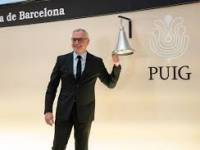
EPILOGUE

The meaning of the word "epilogue" tells us that it is the part of the text that describes the fate of the characters that make up the plot. In the epilogue, facts can also be revealed that complement the meaning of the action.
I started this Blogg last 2022 with more than 100 ysears of age and I finish it with more than 101 and already entered 2023, with the hope that it has served to publicize many aspects and details of the life of the last 100 years and truths that surely many people were unaware of the Puigs and their way of doing things. I have left many other experiences and events more particular and private that are currently in my memories. During my long life I believed that I had seen it all, that I had discovered the idiosyncrasy, character and temperament of people, but I would never have imagined the coldness, indifference, contempt and impudence of the Puigs in the face of everything explained.
I made a big mistake when I innocently went to the office of Josep Mª Puig Planas a short time ago to demand the repayment of my loan and instead of showing up, two lawyers received me. A few months ago I claimed a new documented debt and again with no response. That child whom I saw in his First Communion dress, who we were looking after at his family home in Vilassar against the militiamen of the civil war, years later a young student who ate lunch with me and my uncles in our house in Guinardo, whom we gave him work at the request of his father, Antonio Puig Castelló, the same one who asked us for the loan to purchase his headquarters building in Travessera de Gracia in Barcelona and which has not yet been repaid. The same family that years later from their company Flamagas, was copying and continues to copy many of my husband's and mine's Patents. This family that when they asked us for help we did not hesitate to give it to them, is the same one that currently denies me, not help, but the return of my borrowed money, of the royalties that have been avoided and are avoiding paying me for many years by copying my lighters and other products. Years ago they gave me the excuse that they couldn't repay my loan because business was not going well. Currently they can no longer give me this excuse, it is obvious and public, they simply keep quiet and in a bewildering and surprising way they hide in their ivory tower. Similar is his attitude of delirium and delusion with the publication of numerous lies that I have explained above.
Antonio Puig Castelló, my uncle's first cousin who began humbly as a representative and who had four children, all younger than me and three already deceased, have known everything I have told over the last few months. Josep Mª Puig Planas has experienced it in person. His children, the third generation, follow the same family style and they are where they are partly thanks to me and my family, because they do not stop copying my patents every day.
They have received medals from relational networks, from friends and entities, who did not know the true history and the path that the Puigs have taken to reach their vantage point. Many people have remained on his way, not just me, unfortunate cases that I am not going to explain now. I am very proud of my Centennial medal and my late husband's medals won at the risk of his own life during the civil war and our work. These are true medals of life. Currently, I enjoy my family and I am pleased that the abject performance of the Puigs has finally been made known to me and to society.

Medal of my Centenary

Two of my granddaughters, Mónica and Maria
I appreciate all the several thousand visits to my blogg and received messages of support and understanding from many unknown people. I and my family will continue to claim in the Courts as long as it is necessary, ours and the compensation for the daily copy of our Patents, as well as denouncing everything apocryphal about the Puigs.
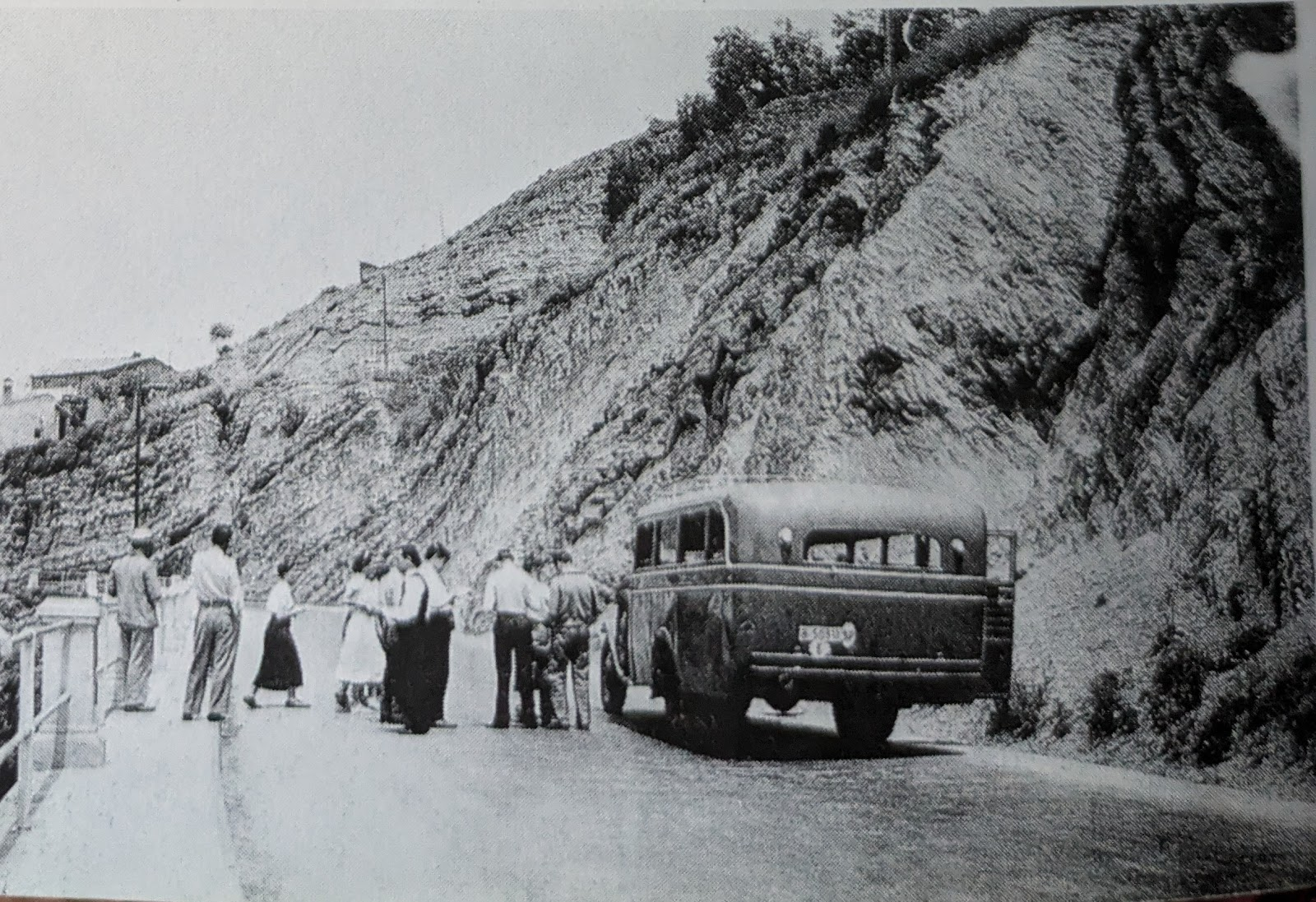
 War Factory No. 7 and its ammunition production
War Factory No. 7 and its ammunition production My grandmother Roser Sans and my aunt Elisa Balagué
My grandmother Roser Sans and my aunt Elisa Balagué



.jpg)
.jpg)

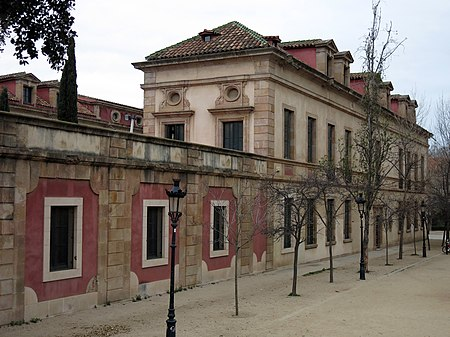
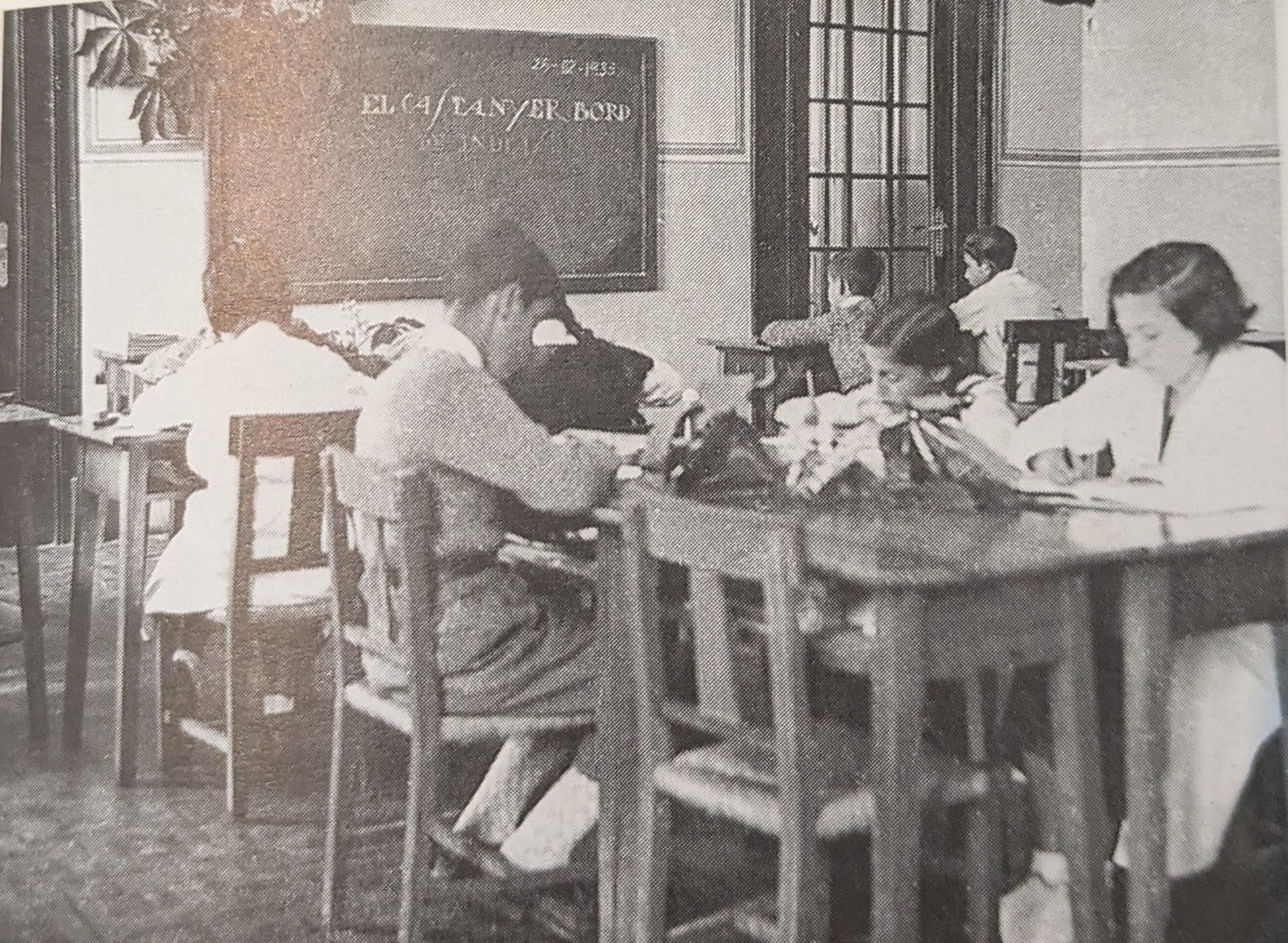


















Comentarios
Publicar un comentario